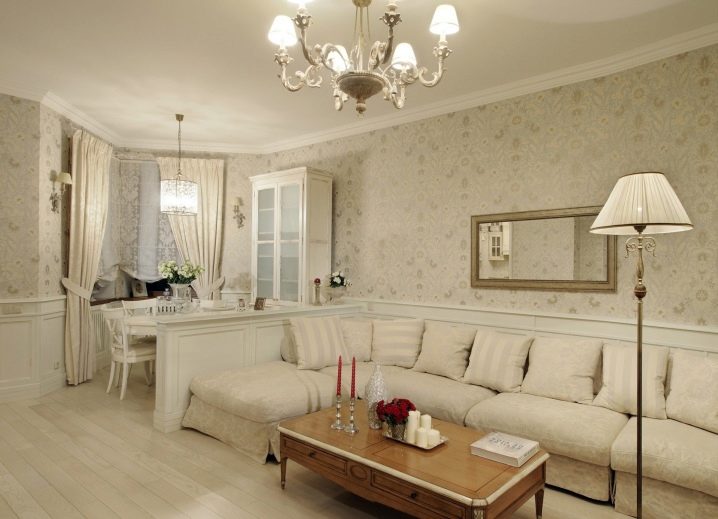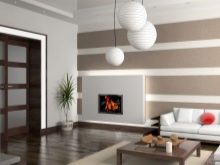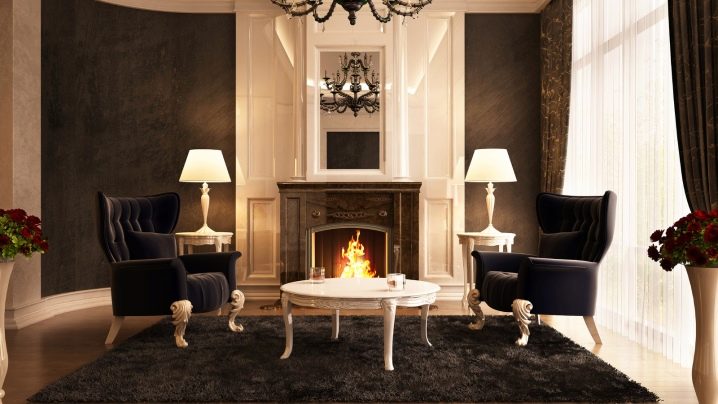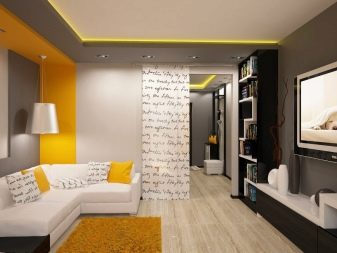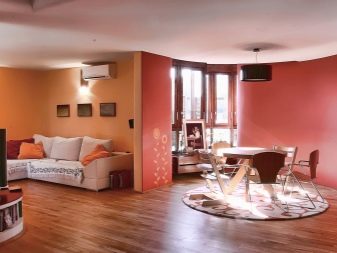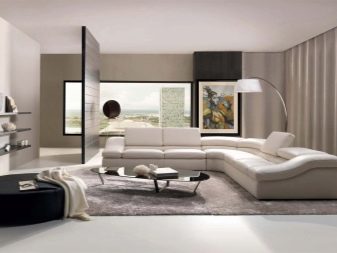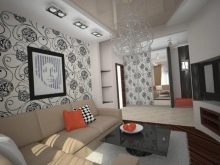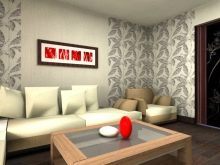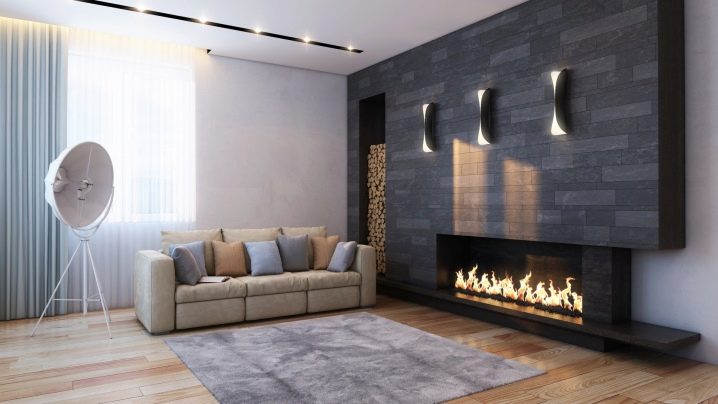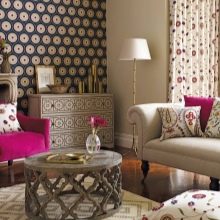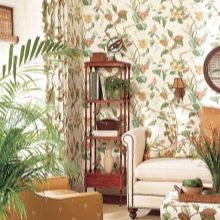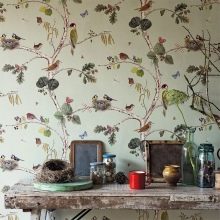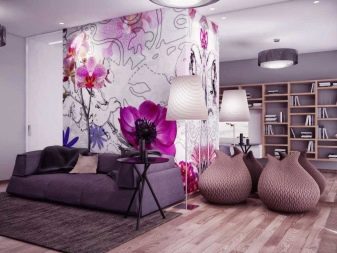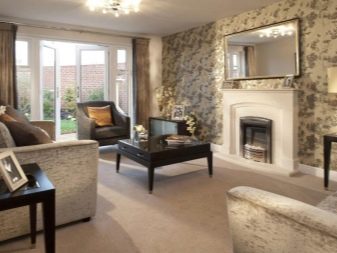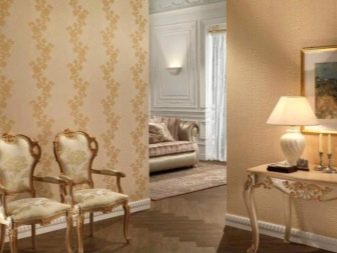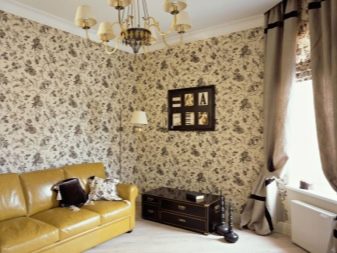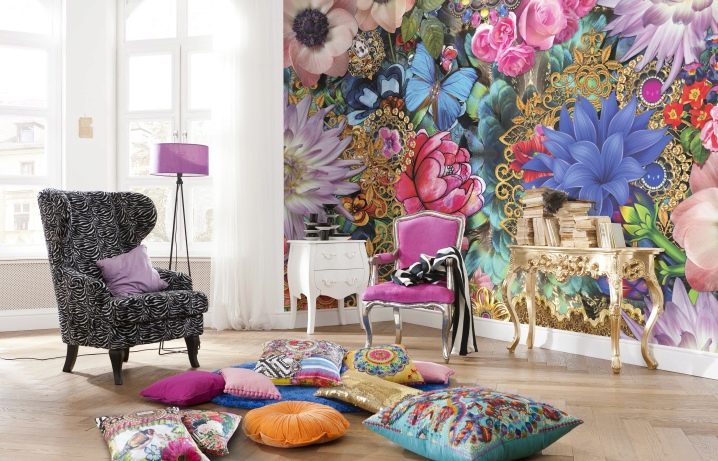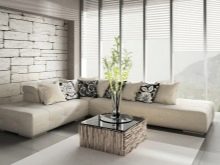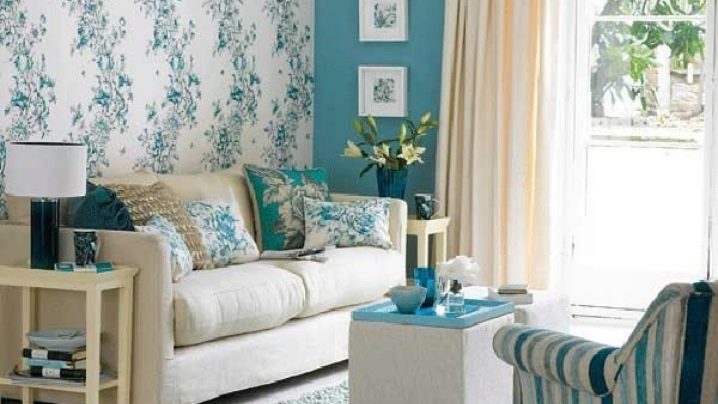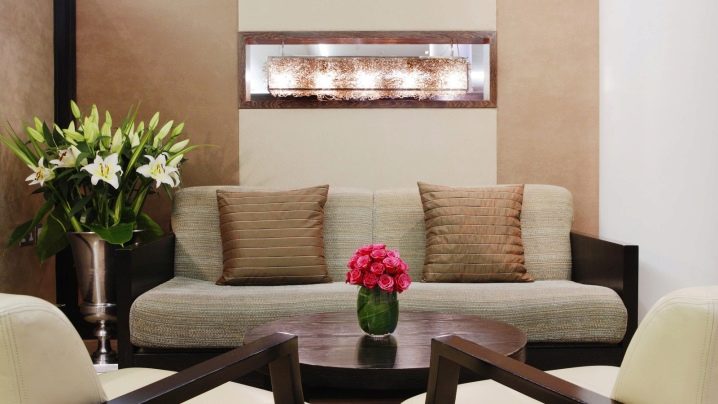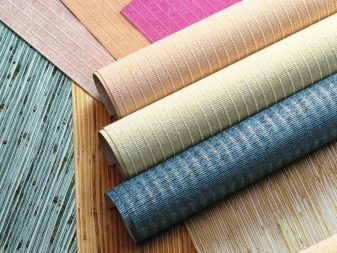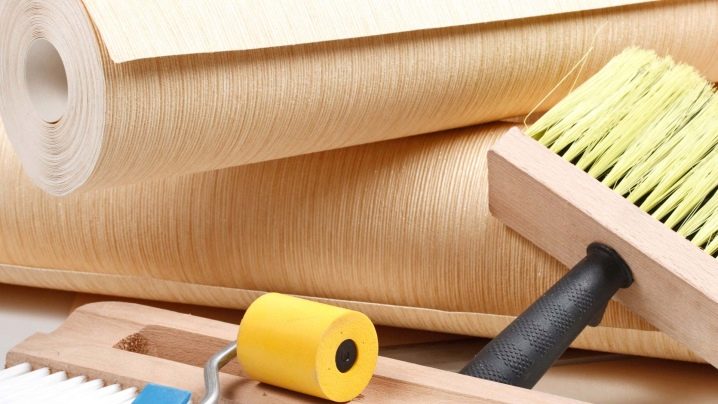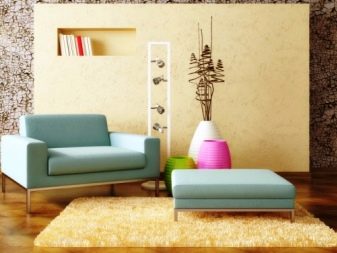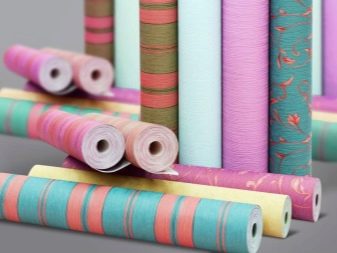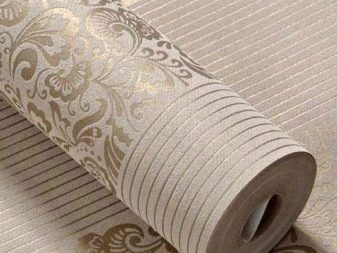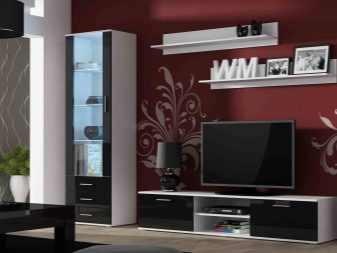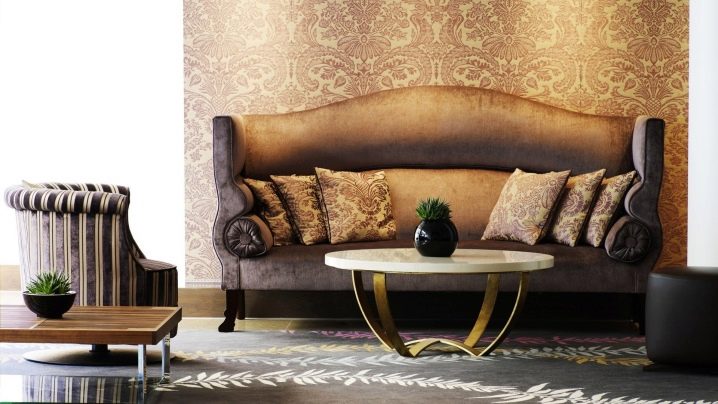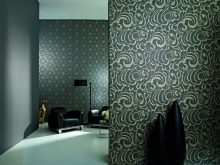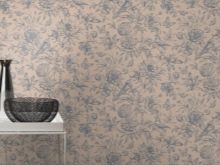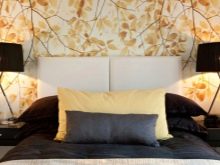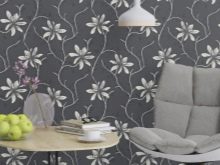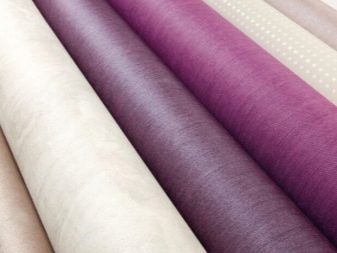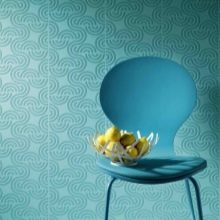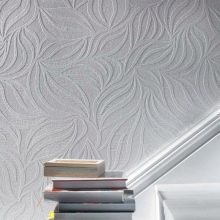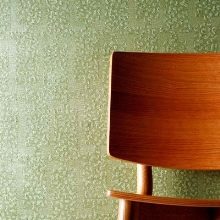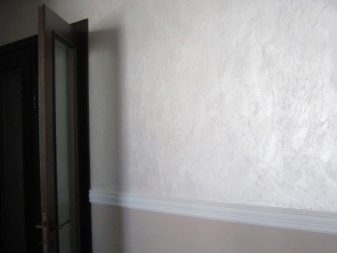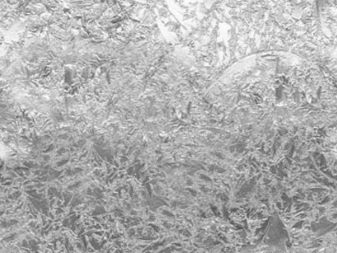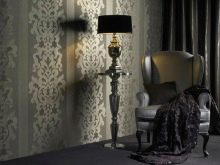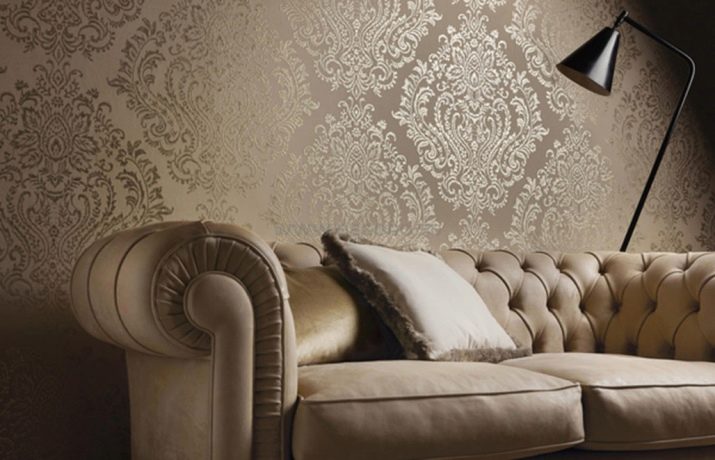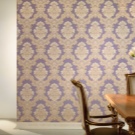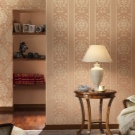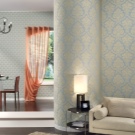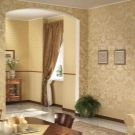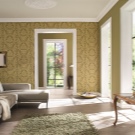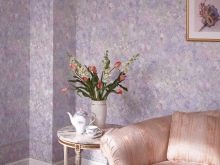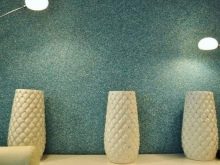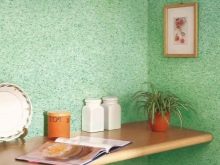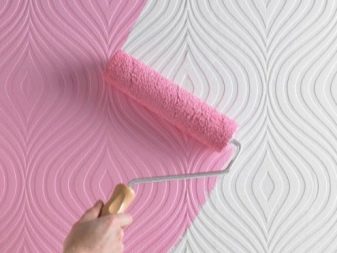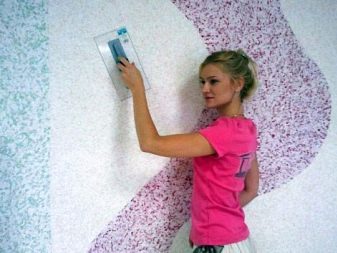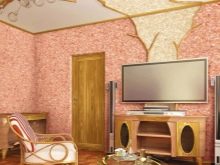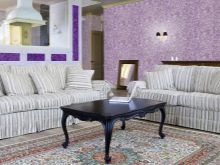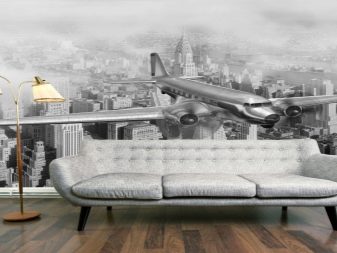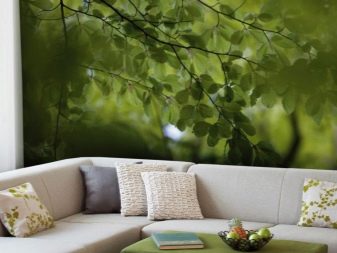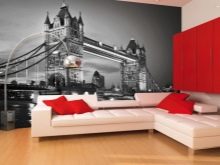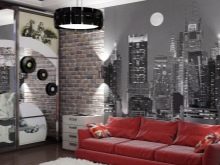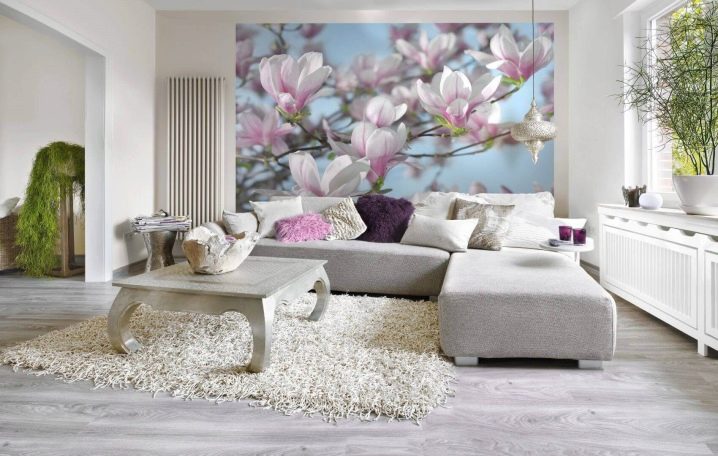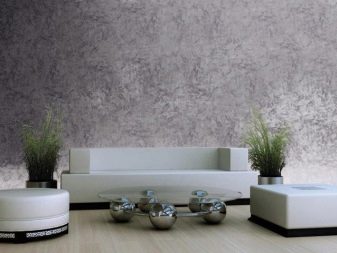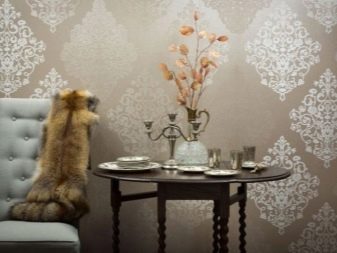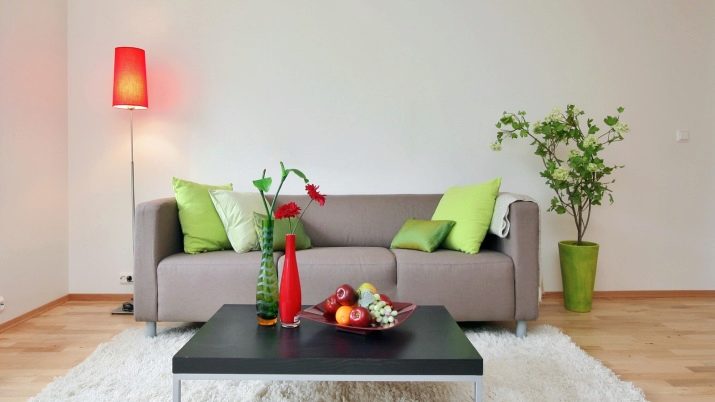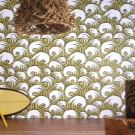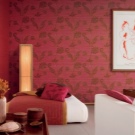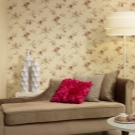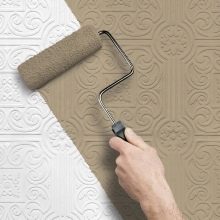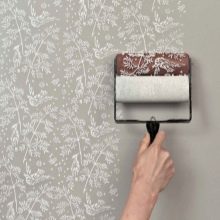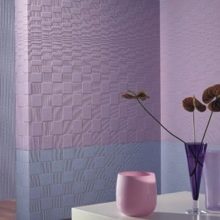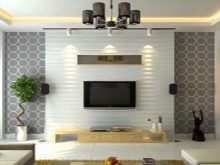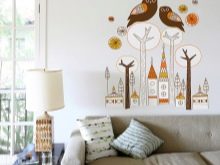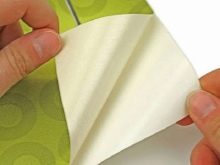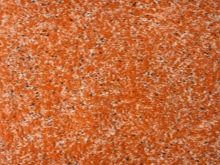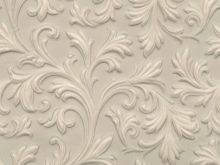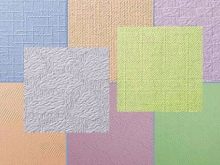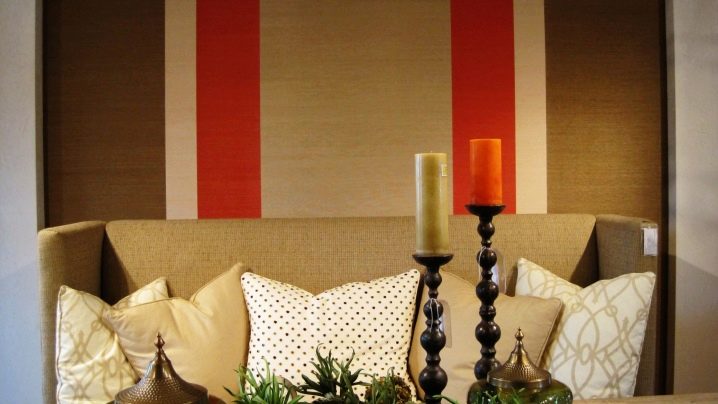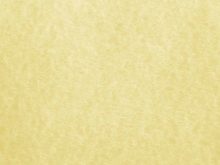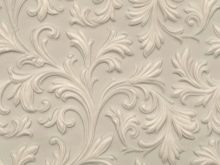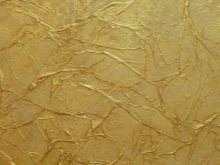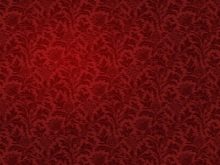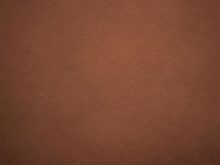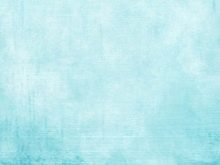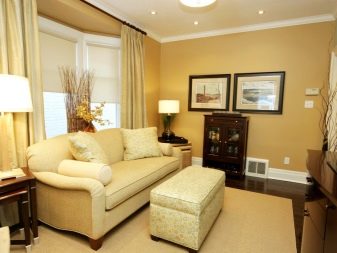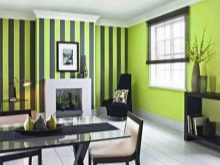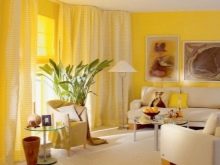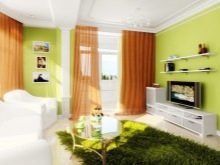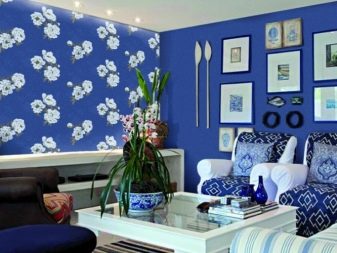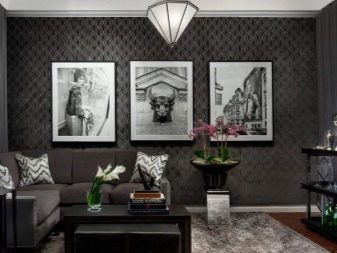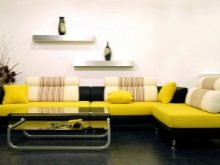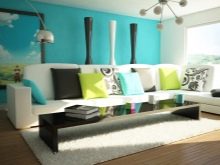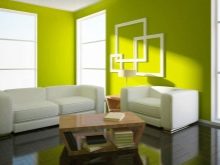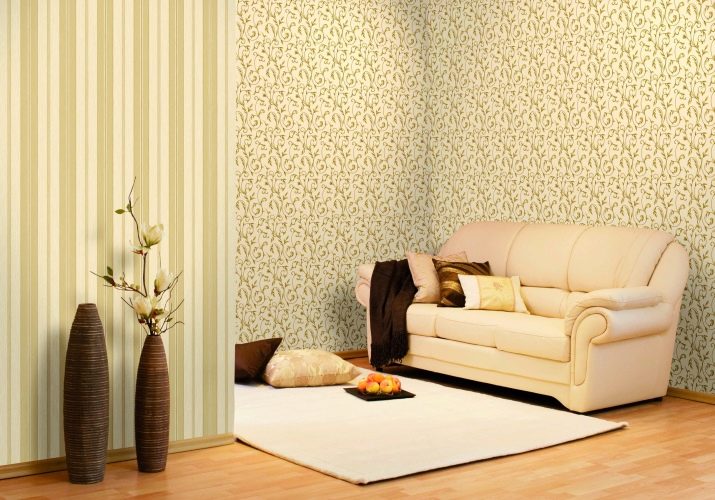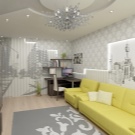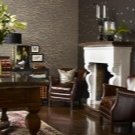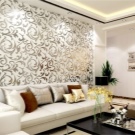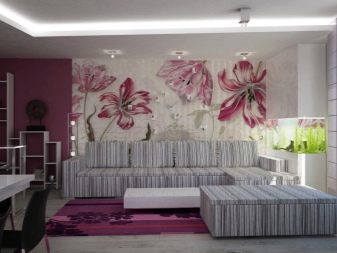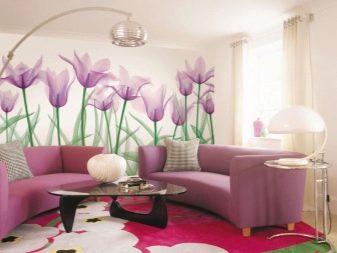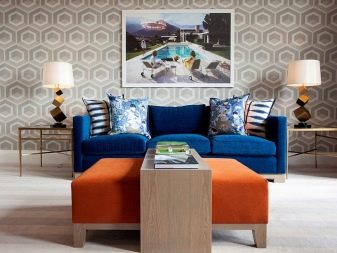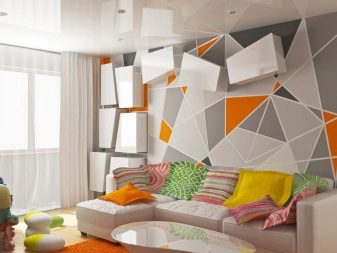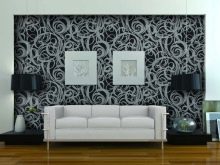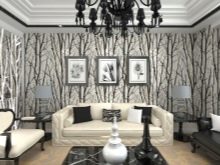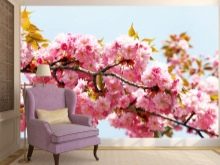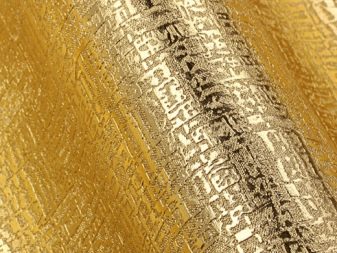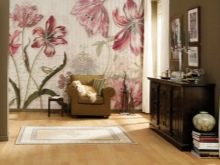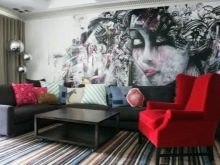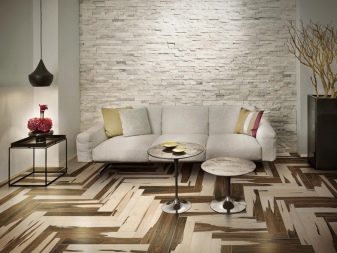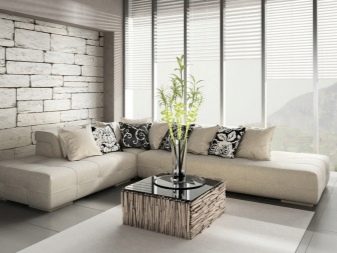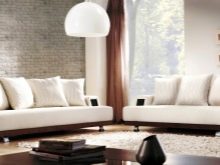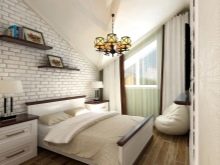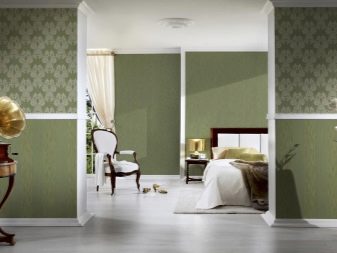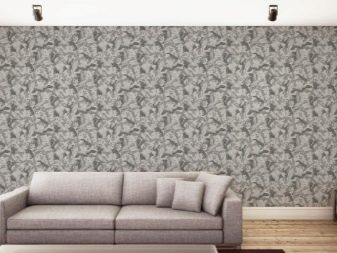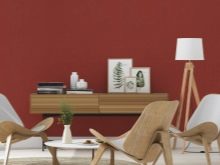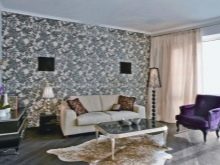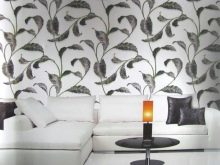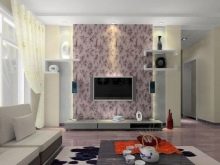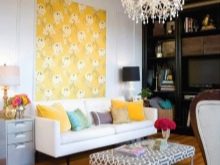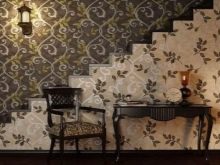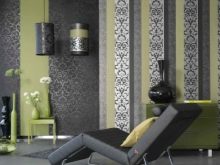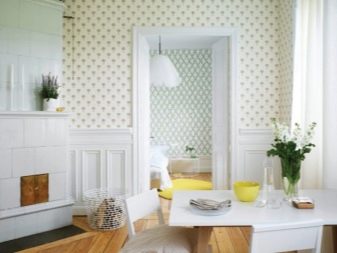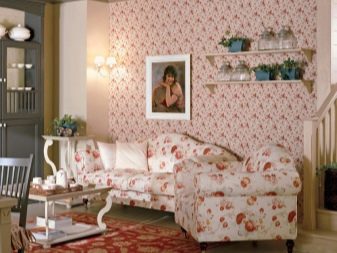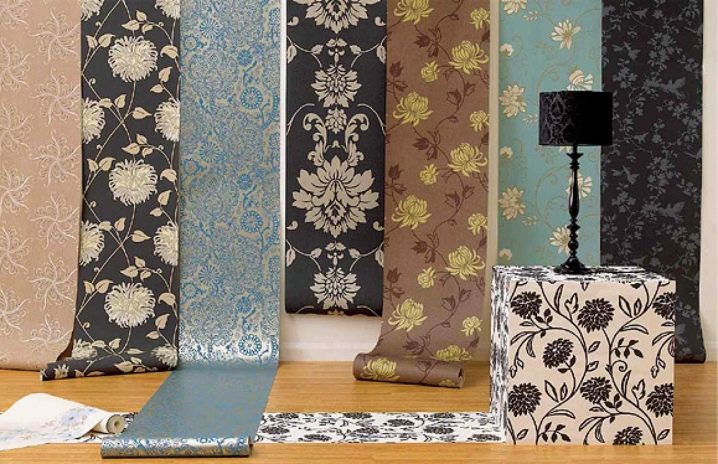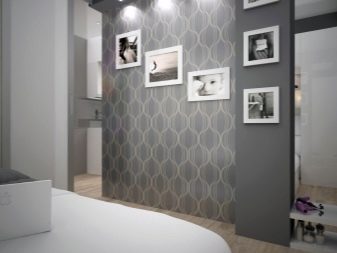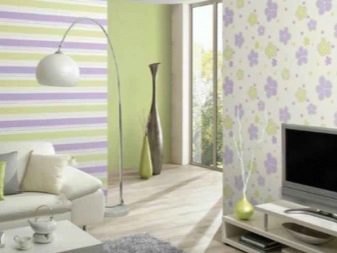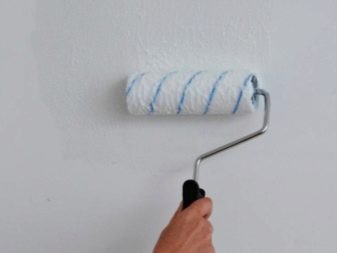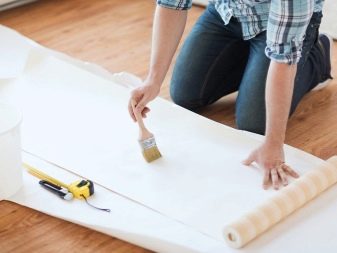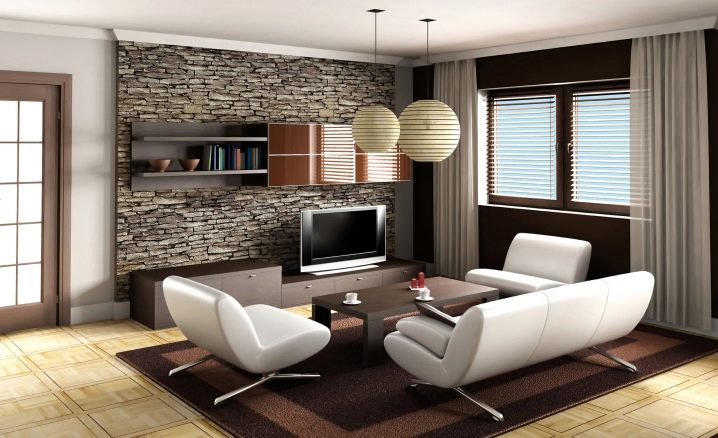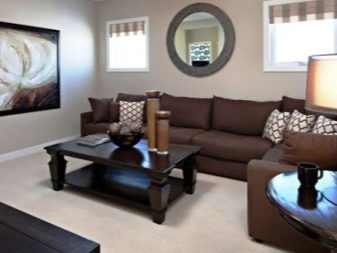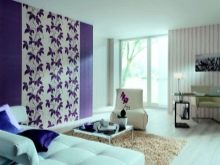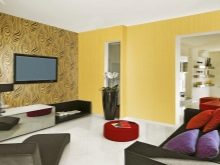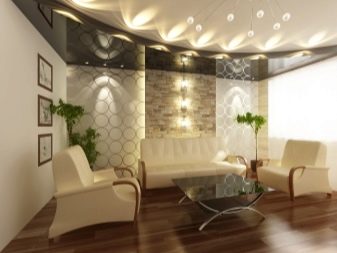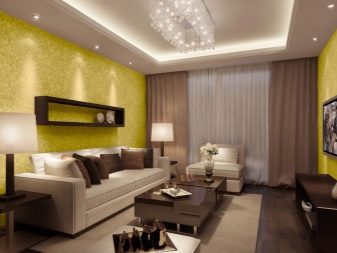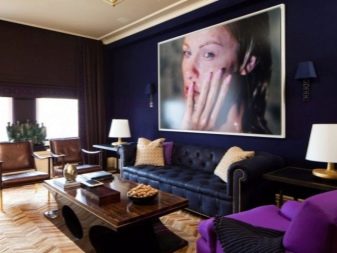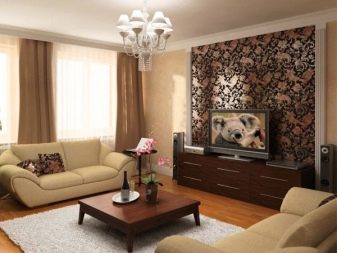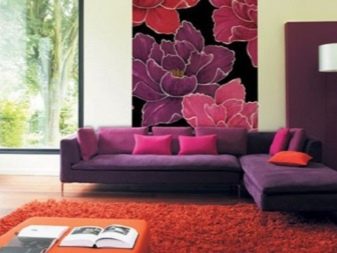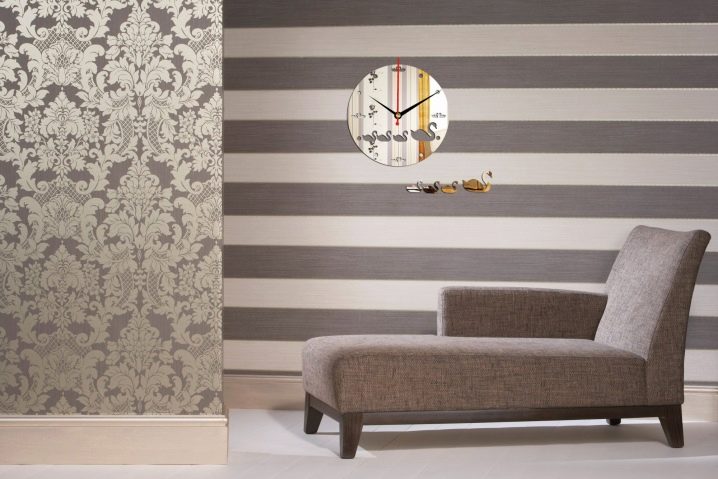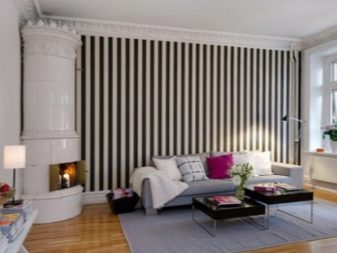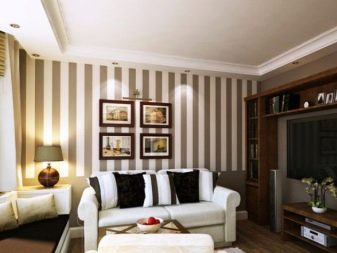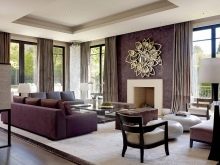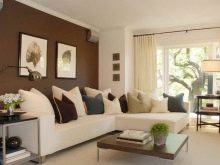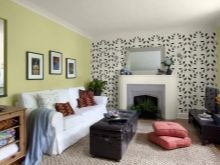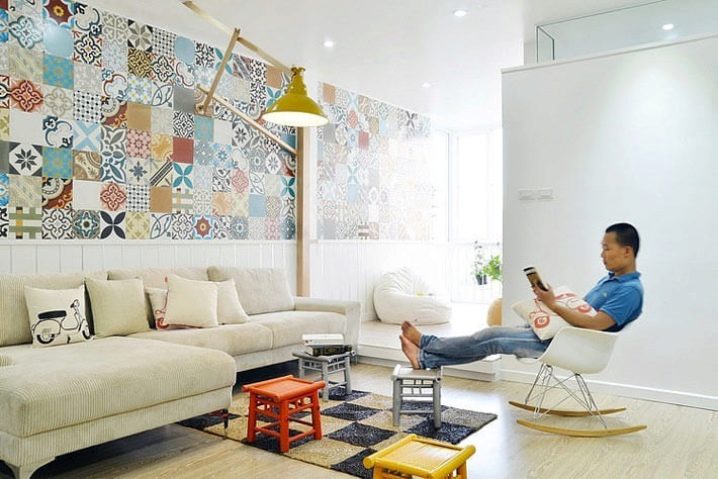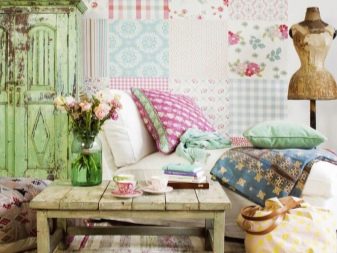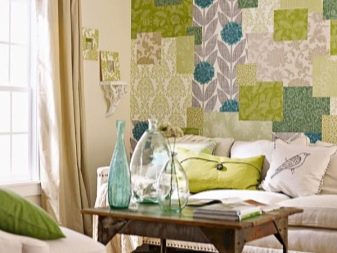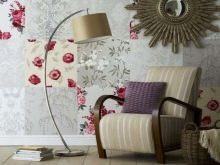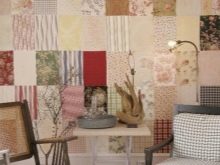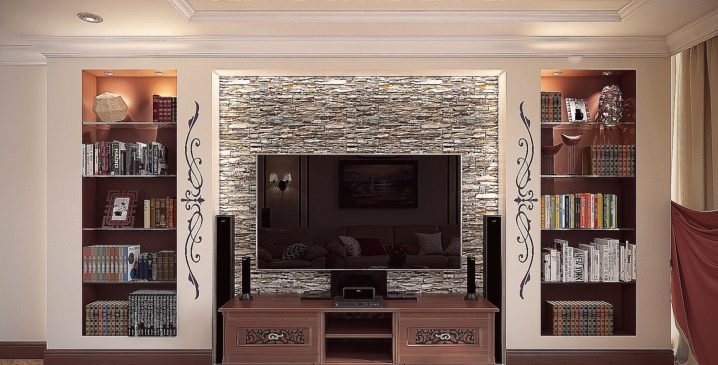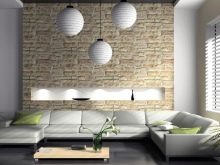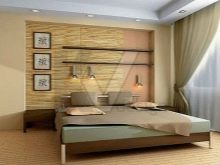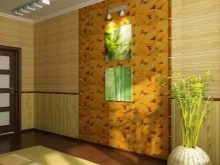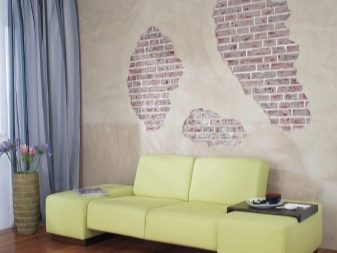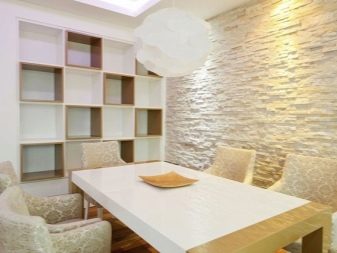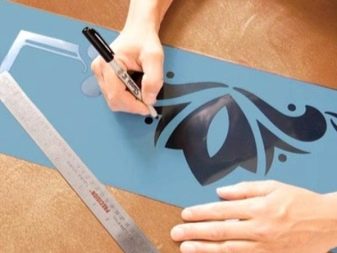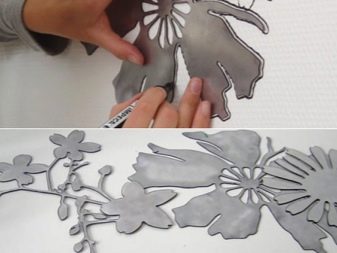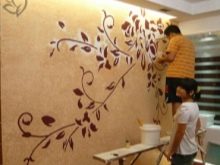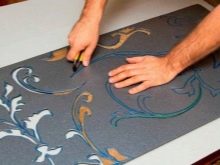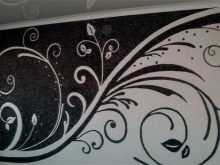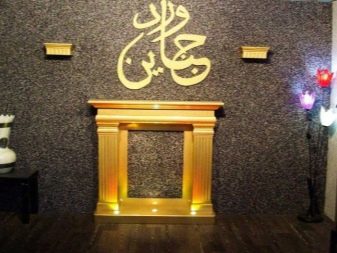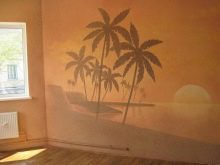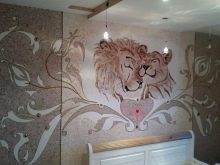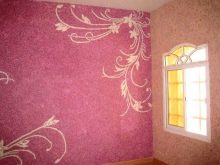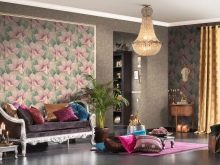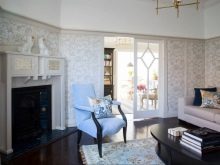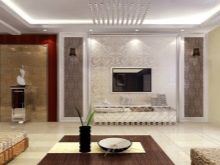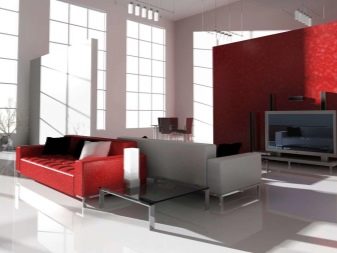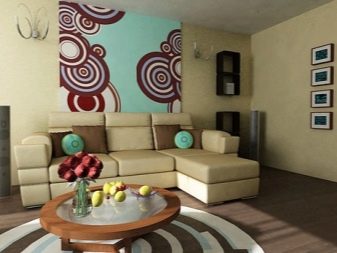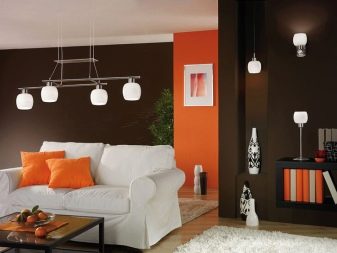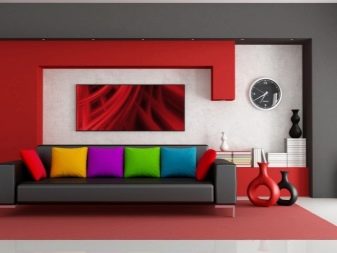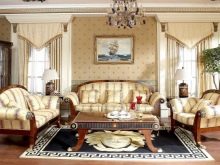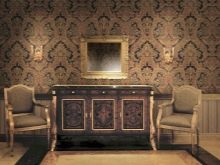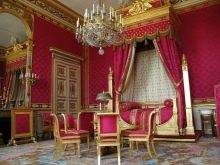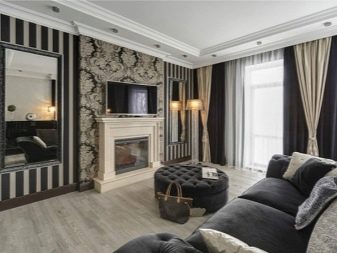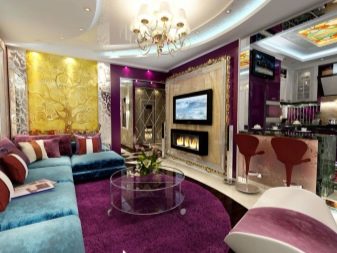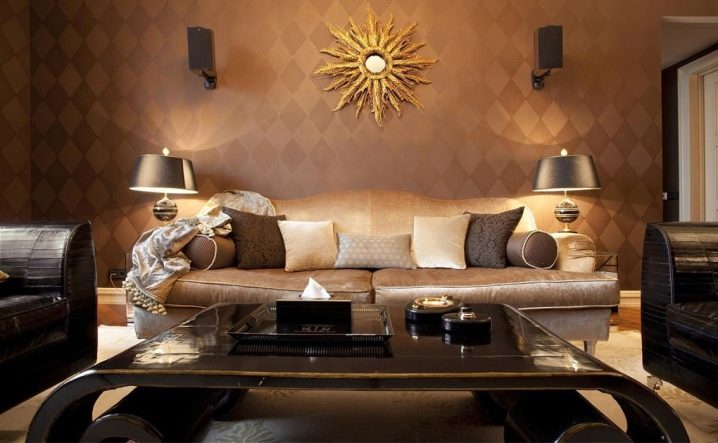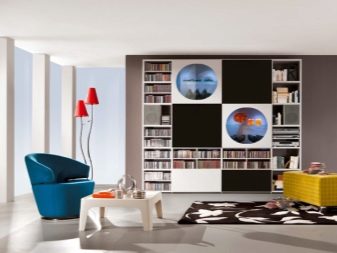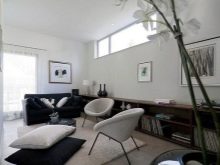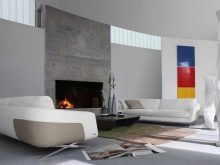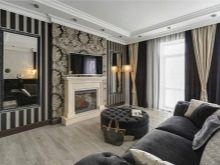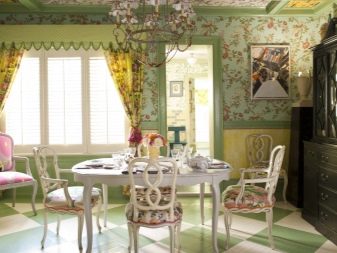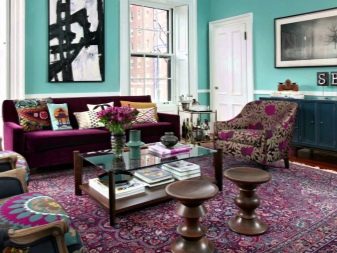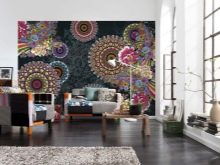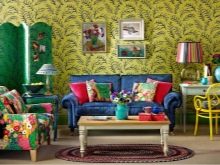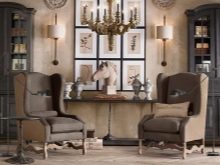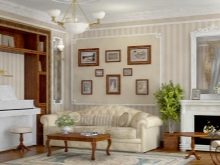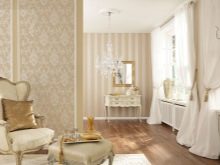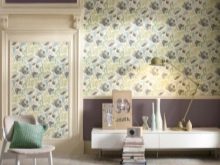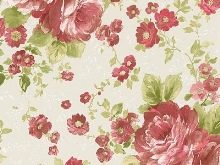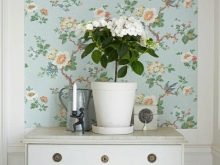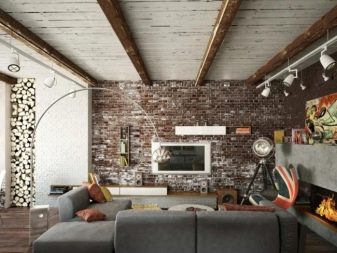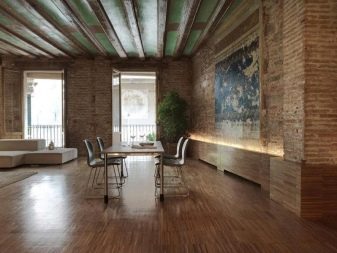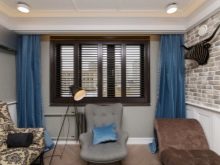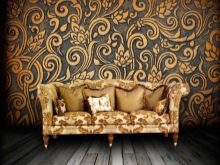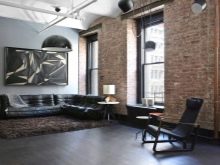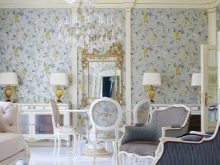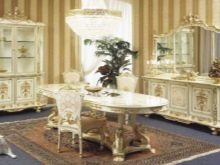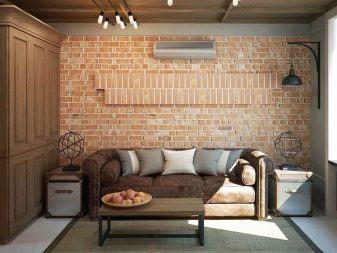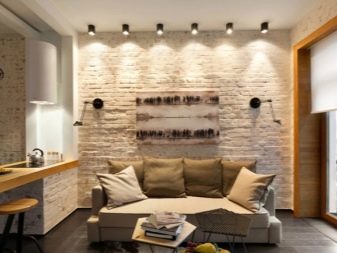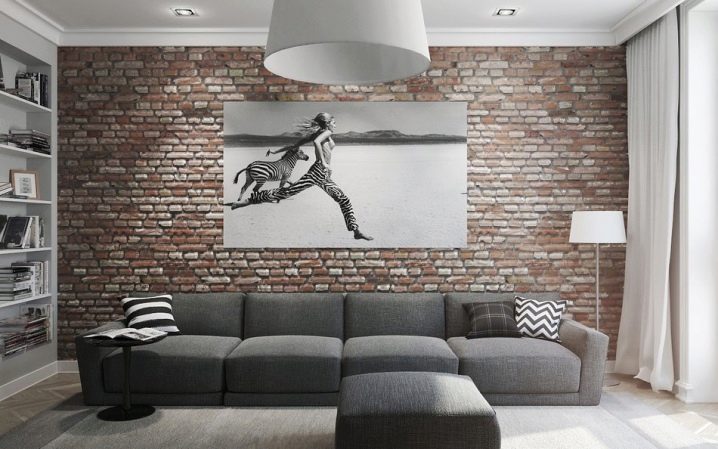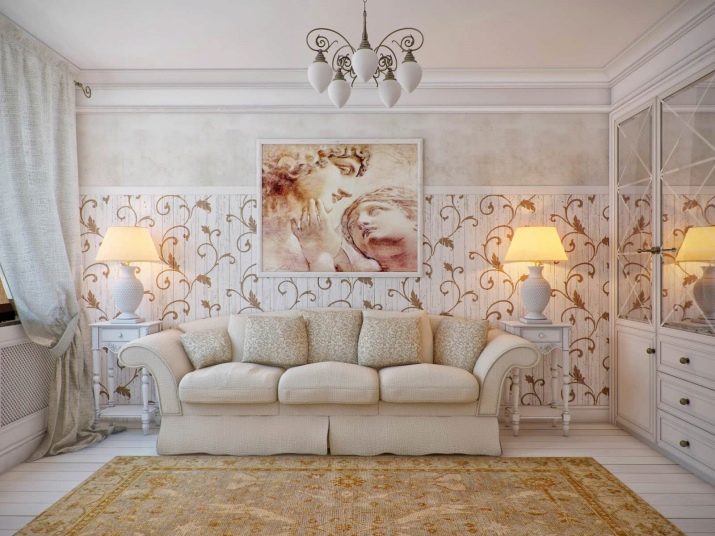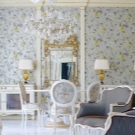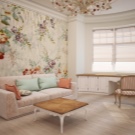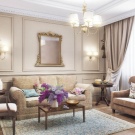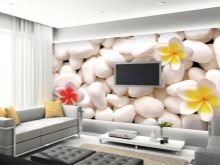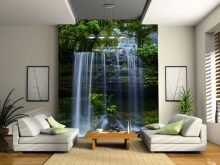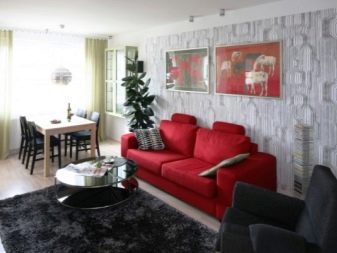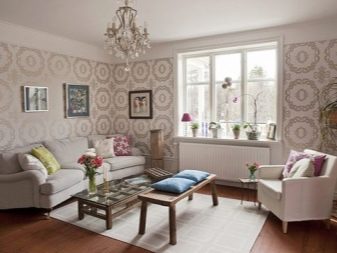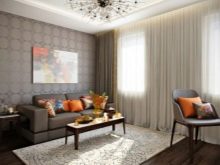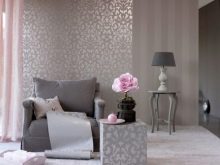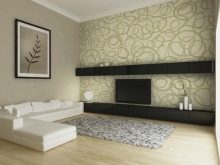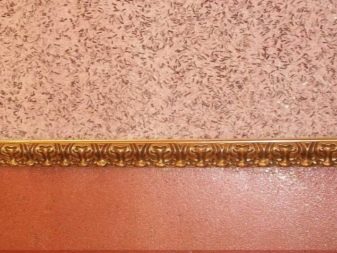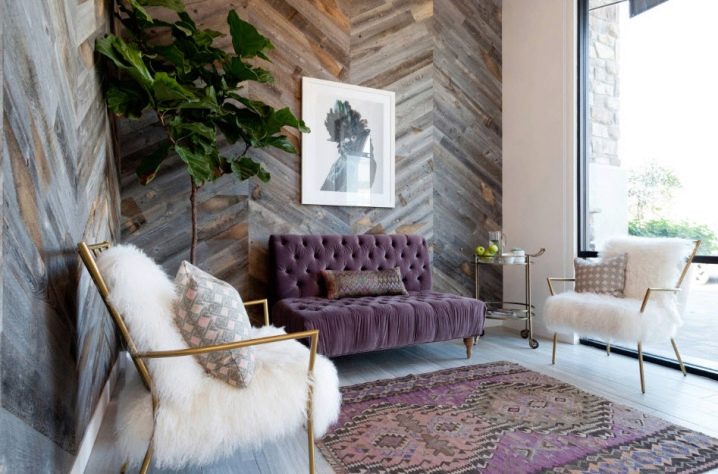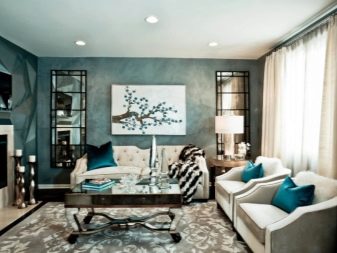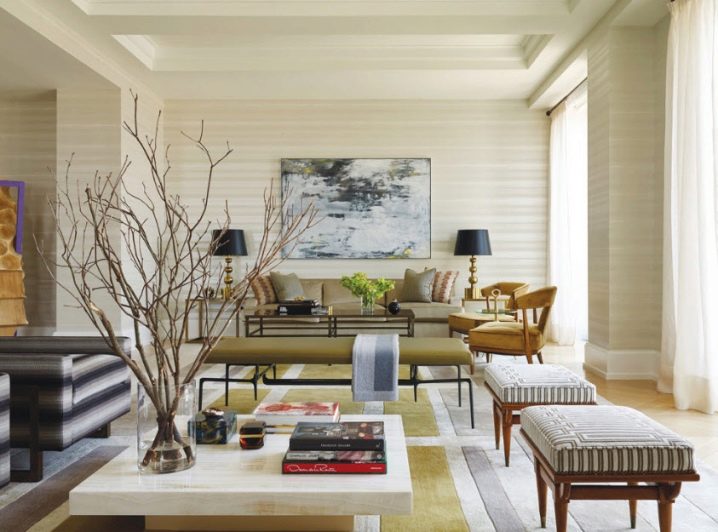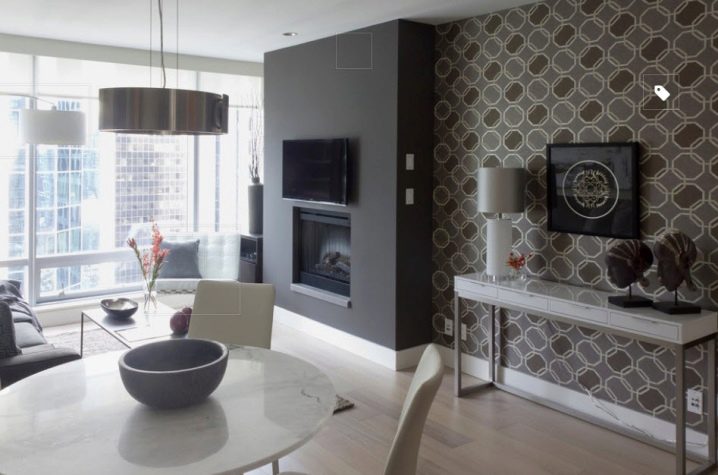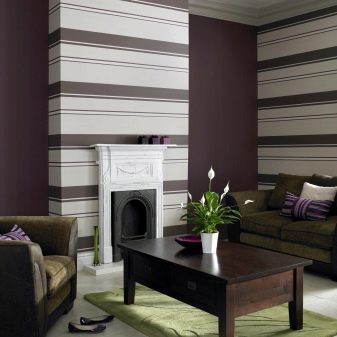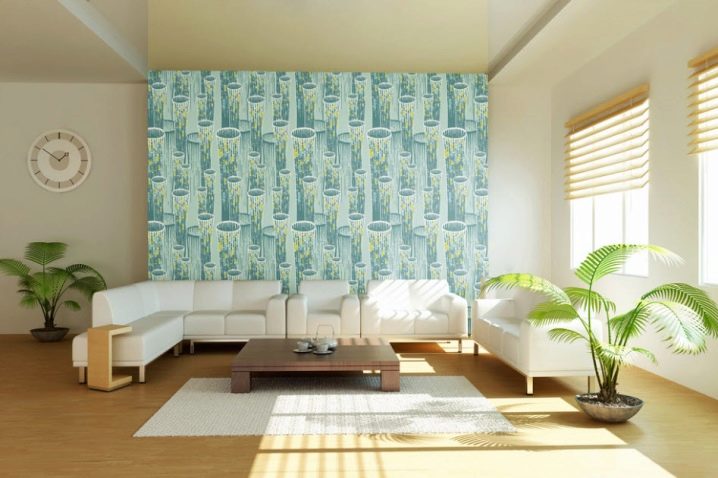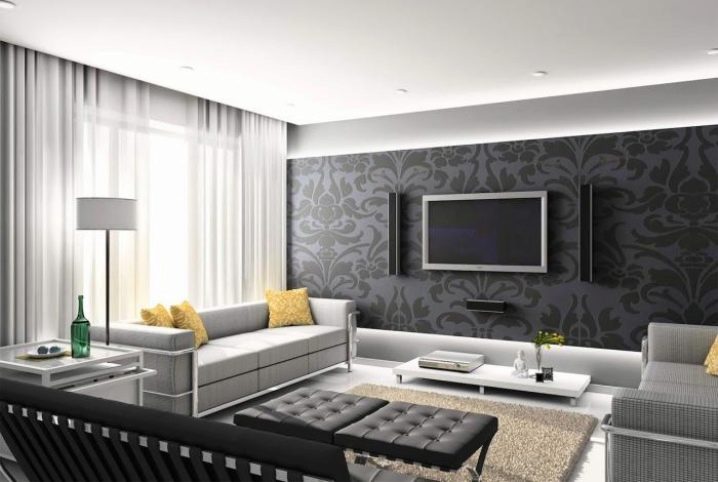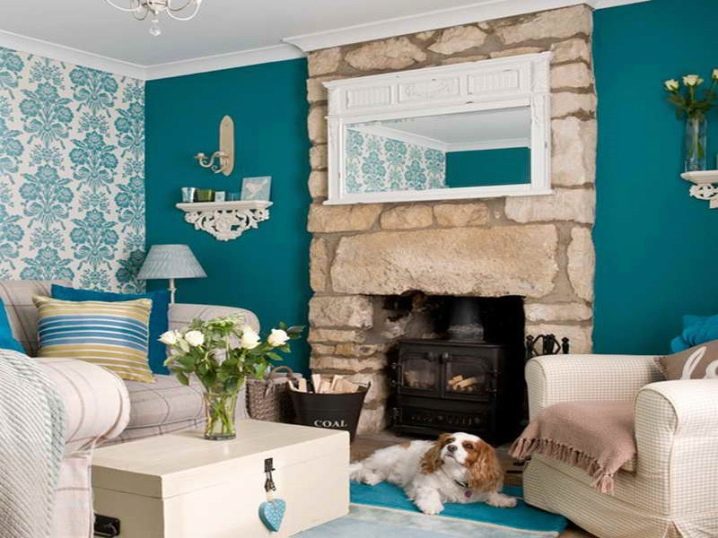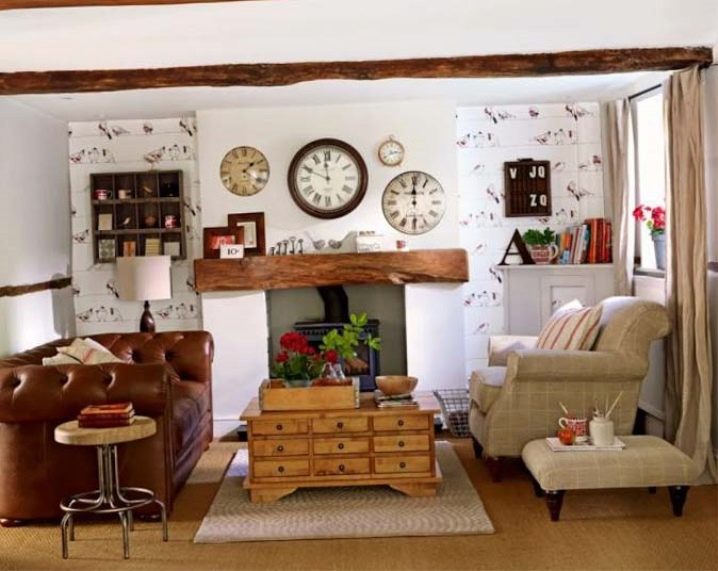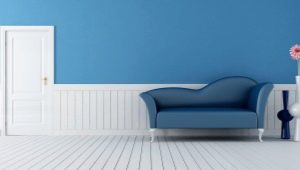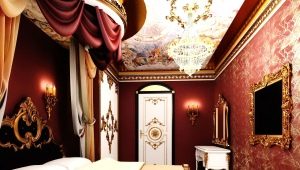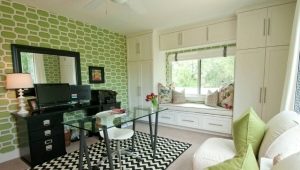Interior hall: choose wallpaper
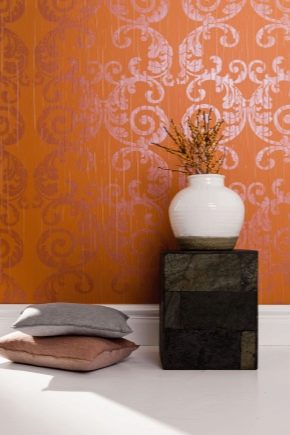
The interior of the main room of the house requires a special approach to the choice of each element. One of the most significant details of the situation is the wallpaper. It is they who determine the mood and set the desired tone for any design, filling the room with the atmosphere of home comfort.
So that they really create harmony in the interior of the hall, the approach to their choice must be thorough: you need to take into account a number of factors, among which are the features of the room, the composition of the material, its texture, width, method of application, design techniques. In this article we will look at how to choose the wallpaper, and how modern veneer with the techniques of fashionable design.
Room features
Hall or living room - a special room of the house.This is the place where the whole family gathers, the room where guests are invited for a pleasant chat. This is a festive zone in the case of family celebrations, a common room for all who live in the house, so the interior of the hall should take into account the interests of everyone. The room must be comfortable, comfortable, different disposable environment. It does not matter, in a city apartment, country house or cottage, it is located: harmony is appropriate everywhere.
Not always the living room space is sufficient. In most cases, the hall is a small room, sometimes it’s a “Khrushchev’s” room by no means the best layout. The room may have corners, protrusions, a broken perspective, which complicates its perception and requires proper use of cladding.
Often, you can notice and clearly curved walls with a difference of up to 10 cm. In addition, the hall often has the disadvantage of the arrangement of windows and doorways, which can be evident.
In some cases, the difficulty lies in the insufficient height of the ceiling, which creates a pressing atmosphere, visually reduces the usable area and complicates the choice of wallpaper.
However, whatever the features of the room, global repair of the hall with the demolition of load-bearing walls, an increase in doorways is not always needed. This can lead to subsidence of the walls and greater aggravation of the negative perception of space. Often in order to be nice in the room, enough to choose the right wallpaper and furniture. Moreover, the lining is almost always the basis for the interior: it indicates that it is appropriate for interior items in a given room.
The design of the hall, in turn, hints at the theme of the other rooms of the house, which can be expressed in shades of color palette, the texture of the lining used and other factors, depending on the case.
Lining advantages
Facing the walls of the hall wallpaper has a lot of advantages. This material:
- it is made on modern technological equipment, thanks to which it is distinguished by high quality and practical characteristics;
- changes the aesthetic perception of the space of the hall, giving it the desired direction of style, taking into account the capabilities of a particular room;
- allows you to beat the flaws of the room, to divert attention from them, or specifically emphasize a special design technique, turning them into the dignity of the room design;
- It is not limited in the subject of print, which allows you to use wallpaper as an element of decorating the space, through which you can add personality and the right atmosphere to the room;
- depending on the type of raw material, its shade and print size, it is able to visually beat the lack of space and light, filling the room with space and light;
- it is distinguished by the type of texture, due to which it is able to give the necessary furnishing items the desired status;
- not limited in shades of color palette, which allows you to choose the material in tune to the furnishing or additional interior accessories;
- it has a width variation, due to which there is always an opportunity to carry out pasting the surface with a minimum number of joints, saving material in the places of pasting corners, projections, niches;
- depending on the thickness and type of structure, it is an alternative to sound insulation of walls, reducing annoying outside sounds from neighboring apartments;
- in the varieties with a dense structure is the insulation of the walls, which is especially noticeable in the cold season;
- based on the characteristics of the composition, it is able to mask minor irregularities of the walls, which is convenient and simplifies the process of preparing the base where there is no special need for it;
- strengthens the walls, which is especially important in rooms where there was plaster or whitewash on the walls;
- by means of the hue used and the chosen print theme, it is able to have a positive effect on the household, bringing the right mood and temperature to the atmosphere;
- in many varieties has additional impregnation, through which it acquires resistance to fire, pollution and moisture, the formation of the environment for the emergence of microorganisms, fungi and mold;
- Depending on the type of material used, the method of drawing the pattern, the complexity of the pattern, texture, width and additional effects, it is different in cost, which increases the circle of customers and allows everyone to purchase the lining according to their own preferences and available budget.
disadvantages
There are a few drawbacks in facing the room with wallpaper. Wallpaper for the hall:
- not always chosen correctly, so they look inappropriate, or interrupt the interior composition, having an abundance of variegation and creating a feeling of disorder;
- Depending on the type of material, they require the correct choice of glue, otherwise they may hold on to much smaller vertical surfaces of the walls;
- they are not selected solely on external indicators, as they may not be suitable in view of humidity or the degree of practicality in a particular interior;
- in most cases, they need adjustment of the pattern, which increases the material consumption, leaving after work residues that are not suitable for finishing even small planes;
- it is difficult to combine with each other if the space of the room is small, or two companions with pictures that are not compatible with each other are chosen as the basis;
- in some varieties are unstable to moisture and water, which spoils the appearance of the glued surface, leaving stains after drying, lagging the material from the wall, forcing to carry out an adjustment, or re-glue the wallpaper completely;
- they do not always have a breathable structure, which in apartments with high humidity leads to the formation of mold and mildew, which have a harmful effect on the body of the household.
Types of wallpaper
Today, the construction market has a wide range of interior finishes on a different basis. Wallpapers are universal material available to every customer, therefore, they are in great demand along with other veneers. In the form of release the best types of these products are divided into three types:
- rolled, whose width is 53, 60, 70, 90, 100, 106 cm, length varies on average up to 10 - 15 m;
- powder, sold in packages weighing 1 kg for self-dilution and preparation of the material;
- wet, which is a finished lining material that does not need to be adjusted before work.
In the collections of successful brands there are a lot of wall coverings, however not all of them are worthy of selection as a decoration for the walls of the hall. Immediately it is necessary to exclude from the list of fluorescent and holographic varieties that are inappropriate in the design of the hall, regardless of the chosen style. Among the other types of wallpaper worth noting several groups that have strengths and weaknesses.
Paper
This category of rolled wallpaper is divided into two types:
- simplex - a material consisting of one layer, characterized by a smooth surface;
- Duplex - wallpaper, consisting of two or more layers of cellulose, having a more attractive top layer, sometimes coarse-fiber, consisting of compressed wood chips.
Such wallpapers are common due to the low price, they allow you to save on the purchase of material, are convenient where repairs are often done.
Thin types of canvases are quite capricious in pasting, therefore they often form bubbles, being glued to the surface of the walls. The dense varieties are somewhat coarse. The joints of these categories are peeled off more often. Paper wallpapers are characterized by simple drawings, rustic texture, short service life (up to 5 years). They are afraid of moisture, soak, if water gets on the surface, eventually lag behind the walls, even if the foundation was carefully prepared.
Vinyl
This facing is considered one of the most popular, differing in premium appearance and the presence of several varieties. The category includes wallpaper:
- foamed vinyl;
- heavy canvases;
- compact vinyl;
- silk screen printing.
The simplest of them are foamed varieties, premium wallpaper recognized by hot embossing with a silk structure, through which create one of the most delicate and sought-after patterns.
Vinyl cladding is great for decorating the walls of the hall: wallpaper made on the basis of vinyl or non-woven, perfectly masks the minor irregularities of the walls.
The category differs in different material thickness, excellent performance characteristics and the presence of additional effects, which paper analogs do not have. They are fire-resistant, moisture-proof and anti-bacterial impregnation, capable of decorating the walls of the living room up to 15 years without the need to glue the joints. In their work, they are simple, they do not form waves, bubbles, and at the expense of a meter thickness they allow minimizing the number of joints between the canvases. The disadvantage of the material is the presence of harmful components, which over time make themselves known (formaldehyde fumes are emitted into the air).
Flizelinovye
Wall-paper on a flizelinovy basis is more popular than vinyl analogs. In contrast, they are an ecological finish that is harmless to the human body, so they can be quietly placed in a key room at home. They have elasticity and small thickness. This allows you to paste over even a curved vertical plane so that there is no gap between the wallpaper strips, if necessary, slightly stretching the material.
Prints of this facing are one of the best among all varieties, noticeably standing out against the background of other analogues.
The advantages of non-woven wallpaper include a large width of the fabric, resistance to the absorption of various odors, good breathability. The material consists of 70% cellulose and 30% chemical additives. Non-woven wallpaper created by pressing the fibers of non-woven and cellulose bonded with polymers does not shrink during pasting.
They look like paper tissue, they perfectly adhere to walls made of plasterboard, plywood, porous concrete, and are fire resistant. These wallpapers do not fade under the sun, serve more than 15 years, are more expensive than vinyl analogs, gradually accumulate dust on the surface, and therefore need to be cleaned.
Glass fiber
This roll finish for the hall is unique in its origin: the wallpaper is literally woven from fiberglass yarns, giving them a clear fixation by means of special impregnations. Glass fiber create from soda, sand, dolomite and lime, connecting with paper. Each time the pattern is different: it can resemble a herringbone, a spider web, diamonds, chaotic lines, original lace.
Fire resistance is inherent in these canvases: manufacturers process glass fiber material with special impregnation.
According to the manufacturers, the material is designed for 20 - 30 years of service, has a different density, good vapor permeability: it is not subject to temperature changes and can be painted up to 20 times.
The material is characterized by high quality and durability, glass wall durable, look good on the wall of the hall. However, they can not be glued to the usual glue. With the observance of the pasting technology, this lining will firmly adhere to the walls, especially in places of maximum operational load: this material is resistant to scrubbing and provides for the maintenance with a damp cloth.
Removing it from the walls is problematic. Fiberglass is different from fiberglass, they are composed of modified starch, which increase adhesion to the surface of the wall when pasting. They are made on traditional weaving and jacquard looms, which determines the pattern and texture of the material.
Textile
This finish is one of the best materials for decorating the walls of the hall. It is a predominantly meter wallpaper with a premium appearance under the fabric. The surface of the lining is created by gluing textile threads to the paper base, which can be placed parallel to each other at the closest distance or in the form of weave.
Material can be carried out with a flizelinovy substrate. The decoration itself is distinguished by pleasant tactile sensations; it warms the walls.
In the development of the front surface trademarks use cotton, silk, wool, canvas, jute and polyester. Textile wallpapers are excellent sound insulation: they absorb sound better than paper and vinyl counterparts. In work, they are quite capricious: it is unacceptable that the adhesive substance gets on the woven surface, it spoils its structure. To glue textile wallpaper, you only need to glue the wall with a glue, since the substrate allows it. In the care material often allows the treatment of the front surface with a vacuum cleaner or a semi-dry sponge. These wallpapers are durable, serve up to 15 years.
Liquid
This hall lining is a packaged wallpaper, which is sold in the form of powder or ready-mixed, due to which the latter is more often called “wet wallpaper”. They are not decorative plaster, as they do not contain sand or plaster. Liquid wallpaper, which resembles a sour cream mass, is divided into colored varieties and analogues for painting. Compared to wallpaper rolls this lining is more voluminous, it is thicker, perfectly masks the irregularities of the walls, does not need thorough polishing of the base surfaceas it interferes with the strong adhesion of the material to the base.
The material is divided into three types: cellulose, silk, cellulose-silk wallpaper. Of these, the finest are textile varieties with silk fibers.
Liquid wallpaper is applied in several ways:
- by means of a spray gun;
- using a construction roller;
- manually with a spatula, site by site.
Application methods depend on the type of wall decoration. They affect the degree of consumption of the material, which with a normal lining takes 1 kg per 3-4 square meters. m. working surface. Depends on the flow rate and the method of preparation of the material, which in the case of the powder is soaked with warm water and allowed to brew for about 12 hours. Wet wallpaper to dilute is not necessary, their consumption is more.
The advantages of the material include the uniqueness of the appearance, excellent sound insulation of the walls, the originality of the drawings, the possibility of using the ceiling. Liquid wallpaper allows adjustment of the lining until they are dry.In addition, the material allows the dismantling of the problem area, which was contaminated during operation. The disadvantage is the need to cover the finished lining with a special acrylic lacquer, otherwise the wallpaper is unstable to mechanical damage and moisture. It is important to observe the same thickness of the layer when applied, otherwise the relief may lose the feeling of solidity.
Wall mural
Photo printing is one of the universal methods of decorating the living room walls. Photowall-paper represent facing with full-fledged drawing of different subject. More often it is a specific composition, which can be made in the form of a single piece of cloth or composite canvases of different sizes.
The size of the photo wallpaper can be from 1 m or more, up to the area of the whole wall.
Essentially, wallpapers are space zoning tool. They are glued solely as wall decoration, so this lining needs additional wallpaper, smoothing the contrasting pattern. Wall mural is often capricious in pasting, especially if the material is thin. When gluing on a vertical surface, they can break, so pasting should be as delicate as possible.
Acrylic
Acrylic wallpapers are analogous to foamed vinyl wallcoverings. The difference is the deposition of a layer of acrylic spraying on the paper or non-woven substrate, by means of which the relief is created. The method of applying acrylic point: it allows the material to be breathable and makes it appropriate in facing the walls of the hall. This wallpaper is cheaper and thinner than vinyl analogs, different good moisture resistance and wear resistance to mechanical damage, are not limited in decorative characteristics, provide surface cleaning with the use of wet sponges without the use of abrasive substances.
The texture of acrylic wallpaper is often reminiscent of brush strokes with a wide brush, or convex points. In cladding, the material is somewhat more complicated than vinyl wallpaper, although they glue them together, too. When applied to the back surface of the wallpaper glue, the glue should be allowed to soak into the wallpaper, after which the wallpaper should be glued to the wall.
With a lot of advantages, the material is not suitable for lining rooms with high humidity.
For painting
This category includes paintings from a series of paper varieties - duplex, raufazer, glass wall paper,anaglipt The uniqueness of such wallpaper is that for their facing does not need to customize the picture. Material consumption is economical, the seams are almost imperceptible. Painting is carried out with a roller using acrylic, latex or water-emulsion paints. The entire line of wallpaper for painting well masks the irregularities of the walls due to the relief texture. Such wallpapers are multi-layered canvases. Each layer of any material is impregnated with a special substance.
Among paper types, coarse-fiber wallpaper with a relief surface created by placing wood chips between two layers of paper is particularly popular.
Such materials are easy to work, they are well glued to the surface of the walls and ceiling, leveling with a rubber roller. Flizelinovye varieties for painting glued no worse than paper counterparts. In this case, there is no need to glue the wallpaper itself: just glue on the treated surface of the wall. However, the lining must be careful not to accidentally remove the vinyl coating from the front surface.
Self adhesive
To date, wallpaper with a sticky substrate found wide application in the decoration of certain vertical planes of the living room. This is not just a self-bonding for furniture renovation: a modern approach to unusual lining allows to easily beat the features of the premises with a broken prospect. Due to the diversity of the structure, they perfectly decorate the ledges, niches, restore or simply update the wall panels of the living room, as they provide for a different type of permissible base of the walls.
Self-adhesive wallpapers are multi-layered material, in which, in addition to the base and adhesive substance, there is anti-adhesion and protection.
This finish coating is elastic, durable, it is resistant to water and moisture, is not influenced by alkaline solutions, and retains the brightness of the original shades for a long time. Having different widths, wallpapers are a tool for bringing together furnishings into a solid ensemble due to pasting small facades in one design with an accent wall.
They harmless to human health, perfectly combined with laminated or plastic panels, they replace painting and do not need to be dried after pasting.The disadvantage of the lining is the demonstration of flaws in the unprepared surface of the wall: it will show pits and tubercles. In addition, the lining process does not provide for re-sticking wallpaper: incorrectly pasted material is removed from the surface and replaced with a new one.
Coating textures
The texture of the wallpaper is one of the significant characteristics of wall coverings, through which you can convey status, hint at the special taste of the home owners, demonstrate the ability to make a stylish and fashionable design. It is the type of surface that determines the degree of comfort and premiumness of the interior. It may resemble the structure of the paper, be hard, coarse, or have pleasant tactile sensations. The most popular wallpaper, the texture of which:
- matte;
- rough;
- relief;
- deliberately rude;
- woven.
One of the most popular design techniques are materials with a plush, velor surface, structure in the form of a canvas.
Woven surfaces attract attention, they draw out any interior, regardless of how the walls are drawn up, be it zoning or pasting all vertical planes.
Color spectrum
The palette of colors of wallpaper for decoration of the hall is multifaceted. Today, each color is represented by a multitude of tones, through which you can convey the desired effect of the atmosphere. Often, up to 5 shades of the same color can be used in one pattern for the effect of depth and volume. Conventionally, the color palette of wallpaper for the hall is divided into several categories:
- neutral (white, gray, silver, black);
- natural (shades of beige and brown gamma, including chocolate, coffee, sand, mustard, a touch of cocoa with milk and a touch of pinkish hue);
- pastel (light and delicate, diluted shades of pink, blue, mint, peach, cream, nude, lilac);
- combined (a mixture of two shades in a soft bleached tone, for example, pinkish-gray, silver-blue, chocolate-golden, peach-orange, coral-pink, smoky-blue color);
- bright (claret, turquoise, brick, green, mint tones).
In addition, paints are divided into:
- refreshing cool;
- warm
A distinctive feature of the temperature of the shade is the ability to fill the special room of the apartment with the warmth of the home (warm sunny shades) or freshness (mint, sea paints).
It is unacceptable to glue dark colors into the room: they are able to add negative to the space of the room, make it visually smaller and hide the degree of lighting in the room. In addition, there are shades that are bad for the psyche of a certain age. For example, it is unacceptable to glue on the walls of the living room violet-blue and black wallpaper, if it often contains elderly households. These tones provoke the appearance of lethargy, which eventually causes depression.
This season the emphasis is on the nobility of the shade. The main background and colors can be any. The main thing is that contrasts should not be screaming. As design tricks of facing are popular today, one shade of wallpaper will not be enough. Even if you choose a material with an emphasis on the uniqueness of the invoice, you can not do without a small accent.
Stylists emphasize: a combination of contrasting tones - what you need for a harmonious and fashionable facing of the hall.
Popular combinations today are layouts:
- sandy beige with turquoise;
- coffee brown and beige;
- orange with gray;
- milky with white;
- chocolate with beige and olive;
- silvery, gray with white;
- beige with blue and light brown;
- mustard with brown and white;
- white with beige and gold;
- woody with gray and beige;
- gray with brick and white;
- white with gray;
- shade of cocoa with milk, beige and blue.
Current prints
A lot of attention is paid to modern finishing of rolled coatings. That is why the wallpaper images today are markedly different from the analogs of the Soviet era. Modern patterns are able to convey the desired atmosphere, to be part of a fashionable interior composition or its bright accent, through which you can zone a space.
Every successful brand aims to offer customers a wide range of patterns, among which the most popular are:
- cherry blossoms in the trees and branches;
- lace motifs with curls and leaves;
- monograms-monograms, which are stylized flowers in the shape of a diamond, framed by woven lianas-leaves;
- flower sketches in the form of artistic painting, abstraction, stylization;
- all sorts of tree branches and single leaves;
- geometric figures, penetrating the canvas in the form of a grid-screen printing.
Stripes, waves, zigzags fade into the background, yielding primacy to plant patterns. However, they are a good design technique, if performed by the embossing method: in the afternoon they are not so visible, but in the evening the wallpaper glitters, revealing the beauty of the pattern through a silk print. Look such wallpaper stylish and expensive, executed in gentle tones of a color palette, they will decorate any room.
An interesting design technique is the use of large drawings in wall cladding. It can be single flowers, realistic canvases of art painting, large paintings, portraits or abstraction. This technique is relevant only in spacious rooms as an emphasis on a small section of the wall, otherwise it can give the living room a sense of misinformation of the area, hinting at the insignificance of human capabilities.
A separate topic is the imitation of rough building materials. Today, this finish is at the peak of popularity. The most original prints of this kind are surface imitation for:
- ceramic tiles;
- mosaic;
- brick;
- a natural stone;
- rough plaster.
Manufacturers
The construction market has a wide range of wallpapers of different brands. In the conditions of tough competition, companies attract the attention of the buyer with collections with extraordinary colors, patterns with special texture and unique tones, which allows decorating the walls of the living room with beautiful materials, creating a cozy atmosphere. Among the successful companies can be noted products of Italian, European brands, manufacturers of Ukraine and the Russian Federation. High-quality and stylish wallpapers with a wide range of brands produce:
- "Slavic wallpaper";
- Marburg Wallcoverings;
- Eco;
- Arthouse;
- Casadeco;
- Omexco;
- Rash;
- Erismann;
- "Practitioner";
- "Saratov Wallpaper";
- "Palette".
With a thorough choice in any of these brands there are coatings that allow you to decorate the walls of the living room fashionably and with taste.
Combining: Pros and Cons
The uniqueness of the wallpaper is the ability to combine with each other and with other materials. If the material is chosen correctly, this design method allows you to add personality to the space of the hall. The combination of wallpaper is a wall covering with the accent zone, which often implies the use of plain wallpaper and a companion with a pattern in the decoration. In this case, the print can be made in different ways:
- paints;
- photo printing;
- embossed;
- relief.
Reception is applied in several cases when it is important:
- to divert attention from the problem area of the room;
- add organization to the space;
- soften the colorful and bright pattern of wallpaper;
- save the room from the abundance of darkness;
- reduce the material consumption to fit the picture;
- to put together pieces of furniture, separated according to the style;
- give space a special status;
- save the room from everyday life and boredom;
- demonstrate the idea of stylistics.
Combining walls with wallpaper is a great way to show your imagination, to unleash your creative potential.
However, the method is not always effective, so it has several drawbacks. With an inept approach to design, he:
- far from always expressive, since it requires taking into account all factors, including the placement of furniture and the installation of lighting devices;
- rarely successful in the premises of the small-sized plan, as it is limited in capabilities;
- depends on the selected material, which is often not combined with each other according to the type of texture, shade, premium;
- does not always relieve the layout of a room with a broken prospect of design flaws, sometimes skewing walls;
- able to visually reduce the height of the ceiling and crush the walls into separate parts, depriving the surface of solidity.
Sometimes the problem lies in the material itself. Not always, choosing a material, the buyer looks at the finish from a distance. Near the small strip, peas, cage and matting look beautiful. But if you look at them, moving at least two meters away from the canvas, the picture will be different. In just a few seconds there will be a ripple in the eyes, so such facing can break the rule of harmony.
How to avoid mistakes?
So that when facing the walls of the hall to prevent mistakes that can spoil the basis of the style, it is worth noting a few rules.
Purchase:
- inspect the area of space: if it is small, large prints and bright colors are admissible in it (this way you exclude the possibility of creating a pressure atmosphere);
- When buying paired wallpapers, choose the material at the same time: it is easier to choose identical tones in two types of cladding;
- try to make a purchase in the daytime with natural light: you can see the real hues of the wallpaper (buying in the afternoon is more absent-minded, so it’s more difficult to choose exactly what you need);
- Pay attention to the compatibility of the material on the texture: eliminate the combination of gloss and a matte surface, this simplifies the premium of the combination and makes the lining scattered;
- think carefully about the color and intensity of the pattern, correlating them with the degree of illumination of the hall and its size: remove screaming paints and pressing patterns from the list: they will start to irritate quickly enough;
- Watch out for the width of the material: trademarks often sell wallpaper partners: you can save money on material purchases and pruning;
- Pay attention to such a nuance: do not take wallpaper for the combination equally, finishing with a pattern you need less;
- when facing walls with wallpaper with different patterns of two types, choose colors so that they do not compete with each other: one companion should soften the other.
Facing
Canvases are not always easy to use. This is partly due with non-compliance with pasting technology:
- walls are prepared for sticking in any case; this is an obligatory stage of work, which includes surface polishing, covering up cracks, pits, ridding the plane of tubercles and applying a primer in one layer, followed by drying;
- after applying glue to the back side, thin wallpapers should be slightly saturated with the compound: leave them for 10 - 15 minutes, during this time you can apply glue to the wall itself (softened wallpapers will not form bubbles after pressing the material with a special roller);
- there is a glue for each material, if it seems to you that it cannot cope with the fixation of specific textured wallpapers, use the proven Moment Extra wallpaper glue for structural and textile wallpapers with enhanced formula, methyl cellulose and antibacterial additives;
- note that the wallpaper is glued after the ceiling, this eliminates damage to the lining in the process of ceiling decoration, and there is no need to tear off the ceiling plinth, if there is one: lead up the inside edge of the plinth line, or cut it off with a stationery knife at the very edge of the joint.
Stylistics:
- if a style with imitation of rough surfaces (for example, masonry under a decorative stone, brick) is chosen as a basis, note: the finish can only be on a few ledges (if any) or on one wall, brute force is unacceptable, it looks ugly, depriving the interior of individuality and feeling style;
- never try to combine different styles in the hall by performing zoning: it is impossible to combine the incompatible, it is tasteless and will destroy any design idea;
- You should not decorate a room with wallpaper to match most of the available interior items: it will become faceless, show the uniqueness of the situation better by using a contrasting tone (if the furniture is dark, the wallpaper should be light, with white furnishings shades of pastel colors are preferable)
- try not to use in the interior of the room the wallpaper partners in combination with white and black tones: they put pressure on the psyche, if there is a lot of black tones, they deprive the aesthetic perception of joy, hinting at depression and hopelessness;
- Do not ignore the principle of four shades in the design of the interior, focusing on the furniture: if the shades of style are not enough, you need wallpaper with a contrasting pattern, with an abundance of colors in the color palette, monochromatic wall coverings are appropriate;
- Using the method of decorating the walls with wallpaper, do not lose sight of the lighting: it is this one that can give the wallpaper the desired look or spoil the aesthetic perception.
Besides,Consider: no matter how beautiful the design of the approximate design of the living room walls chosen from the photo catalog should be, it should correspond to the specific habits and preferences of the household. Otherwise, feel cozy and comfortable will not work.
If a specific sketch or photo is taken as a basis, correct it so that everyone likes the color, texture, pattern. Since the living room is a place with a large cross, think over the lining of the most polluted surfaces. Take care of the practicality of the wallpaper, which can be done using washable varieties.
Combination and design options
Decorating the interior of the hall in modern ways includes several interesting techniques. The design approach is based on the principle of arranging the wallpaper between itself and other facing materials, using color, texture and using elements of the print. The hall is the place where all of them can be applied, regardless of the material used wallpaper. A distinctive feature of the layout is Moderation of accents, which imply wallpaper with a pattern.
Horizontal
One of the complex techniques, which involves the combination of wallpaper by gluing cloths parallel to the floor. This is not a simple alternation of strips of the same width: it is important to correctly raise the height of the walls through a combination of two wallpapers with a smooth transition of the pattern, or using the texture of the material with not very pronounced relief stripes.
It is unacceptable to combine small or catchy strips, playing around with an insufficient height should be imperceptible.
Vertical
This method of decorating the space of the hall implies the use of paired wallpapers: sometimes the layout is done by pasting three walls with plain wallpaper, while the emphasis is on the fourth wall. To finish looked monolithic, one of the shades on the wallpaper of the two types must be identical. In addition, the background is important: the most harmonious version with the same base wallpaper of two types. In other cases, the wallpaper is glued by alternating. For example, having two strips in the corners of one wall.
Zoning
A more popular hall zoning technique is an option with a slight accent.At the same time, wallpaper with a print is placed in a certain place, which is not covered with furniture. The size of the accent is thought out carefully.: it can be located in the center of the wall, emphasize a certain angle, a protrusion, highlight the multi-level plane. Often, wallpaper with a print resembles a picture if the accent is framed with a special frame, using molding, baguette or ceiling plinth.
Through this technique, you can visually change the space, pushing the walls away and giving the room a large area.
Patchwork technology
This technique involves the accentuation of one of the walls of the hall in the spirit of patchwork. To do this, acquire bright and contrasting canvases with a pattern, shades of which echo each other. Cutting wallpaper into small squares or rectangles, they are glued to the wall, filling in the accent, or pasting the entire wall according to the principle of classical or diagonal tiled masonry. The remaining planes are decorated with plain wallpaper to soften the catchy design.
This technique implies accentuation of one of the walls of the hall in the spirit of patchwork. To do this, acquire bright and contrasting canvases with a pattern, shades of which echo each other.Cutting wallpaper into small squares or rectangles, they are glued to the wall, filling in the accent, or pasting the entire wall according to the principle of classical or diagonal tiled masonry. The remaining planes are decorated with plain wallpaper to soften the catchy design.
Selection of design features
The hall, which has a broken perspective, can be beaten with a design technique of deliberate underlining of flaws. In this case, it is possible to combine two combination techniques. For example, you can glue the plane with a protrusion, using a horizontal method of sticking wallpaper with imitation of a wooden board, highlighting the protrusion with a wallpaper-picture in approximately identical colors and equally coarse style. If there are two protrusions, you can use the reception of symmetry, picking up a pattern for the protrusions so that from both sides it looks towards the middle, where the contrasting wallpaper companion will be located.
With other materials
One of the most interesting techniques for combining wallpaper is the principle of their unity with plastic or laminated lamellae, brick or stone walls. At the same time pasting depends on the design features of building materials:
- if the panels are located below, the wallpaper is placed vertically from the ceiling to the level of the ledge;
- when the panels are located on the ledges, wallpapering of the walls of the hall with wallpaper is carried out between them along the entire height;
- If the wall has several levels, the wallpaper highlights one of them.
When performing a combination, it is important to rely on the material of the panels: if it does not have an invoice, it is plain, the wallpaper should be chosen with a colorful print (it will not be much). Having panels under a brick or a stone laying, it is better to add them with monophonic coverings. To the level of materials at the joints was not different, you should use a baguette or molding. When you need to make a panel on a relief surface, you should use plywood or fiberboard, pasting the fragment and framing it in a frame.
Liquid wallpaper design
The uniqueness of this material allows you to perform different patterns on a velvety surface that are resistant to sunlight. You can use different additives, complementing them wallpaper paste. Among the most popular companions of the mixture, mother-of-pearl, marble chips, mica glitter, colored flock, and glitter are especially in demand. This technique is carried out in three ways:
- after drying the finished lining with dyes;
- using stencils;
- manually fitting each piece of the pattern.
The difference between the techniques is obvious: the creation of a pattern in the first case is a classic drawing technique, when painted on a white canvas with special colors, giving expressiveness to the lines with the help of special markers. At the same time, they try to fill the bulk surface evenly, although it is far from being so easy and requires a considerable amount of time to completely paint each area.
Templates used for decorating the walls of the hall, you can buy ready-made, or make your own with thick cardboard.
Conventionally, they are divided into several types:
- monochromatic - patterns for decorating the wall with a pigment of the same color;
- individual components — stencils for staged drawing with wallpaper (for example, individual leaves, flowers, curls) by overlapping one layer with another;
- volumetric - templates, the use of which implies the presence of a putty with the selection of the pattern above the general level of the lining by 2-4 mm;
- anti-stencils are the backlight effect patterns, which are forms for painting the wall outside the stencils (for the background).
Today, the actual prints of this decoration, appropriate in the design of the walls of the hall, are:
- single trees with tender greens;
- fluttering butterflies;
- simple geometric shapes;
- large flowers and leaves for stylization;
- bunches of grapes;
- various curls connecting two contrasting tones.
The third method of decorating with liquid wallpaper is nothing more than filling each piece of a pattern that was previously painted on the wall. Reception is carried out with a spatula with simultaneous trimming of the edges of the contrast area, and filling in nearby areas of the design is unacceptable, since in this case it is possible to shift the design and it is difficult to achieve expressive contours.
On how to properly apply liquid wallpaper on the wall, see the following video.
Design in different styles
To date, there is no style that could not be supported by wallpaper. This lining allows you to design the interior of the hall in classic, ethnic and modern design styles. The choice of wallpaper will determine the classic characteristics of the wallpaper: pattern, color, texture. Consider a few current modern ideas.
Avant-garde
Style implies the use of new technological materials in the decoration. Here liquid wallpapers are appropriate in combination with laminated type coatings, 3D relief panels, and leather trim. Do not do without bright contrast: the color of the walls should be different, the selection of any design features of the room by means of color or artificial lighting is welcomed. The shades of pastel gamut are excluded: the style dictates brightness and creativity, however it cannot be considered full-fledged, without having semantic accents and stylization.
Empire
Palace style, which came into vogue at Napoleon, must personify victory and triumph. It can not be paper wallpaper: welcome dear, including textile wall decoration, art paintings, methods of combining wallpaper on the principle of panels. Decor is of particular importance: the canvas should be pompous, always with gold, silver or a shade of bronze. Will perfectly fit into the style wallpaper with silk-screen printing, textured materials in bright colors (burgundy, wine, blue, bronze shades, the combination of white and gold).
Art Deco
Bohemianism, composed in the era of industrialization, has its differences.The style welcomes bright colors, a combination of abstraction with geometric patterns, the use of modern materials, playing with light. Coatings can have a gloss or polish (relevant for liquid wallpaper).
Popular colors are all sorts of zigzags and stripes, shades of gray, brown, cream and metallic flare are recognized as favorites of shades. Here are appropriate wallpaper with geometric embossed (silk-screen printing), Three or more tones in the wallpaper print and a combination of cloths with tiles are required.
From the design techniques style is inherent in the combination in the style of the panel (framing accents in the contours and frames).
Bauhaus
This style is different practicality, a certain simplicity, a minimum of decorative elements. Wallpapers are selected so as to zone the space, giving it an unobtrusive organization, highlighting each site a special degree of illumination. Neutral shades combined with bright tones (for example, beige with green, gray with wine) are welcome. The colors of the style are based on geometrical shapes, and the walls are also plastered with plain canvases, the color palette of which is yellow, wine, moderate gray, and more rarely brown, green, and blue shades.
Boho
Formerly street-style street style fashion today is one of the sought-after design trends of creative individuals who value comfort and condemn monotony and boredom. There are no restrictions: wallpaper can be any: budget, expensive. The main thing - they should be bright, with a slight touch of vintage. The decor of the walls of the hall is welcome in the reception of patchwork technology: this is exactly what is needed to emphasize the boho.
Ideal colors - national prints in rich shades of color palette. In the classic boho, emphasis is placed on ethnic patterns and a combination of restraint with bright accents. In the environmental direction only paper or textile fabrics based on flax, cotton fibers are allowed.
Vintage
One of the extraordinary trends, representing an imitation of the situation of the past, gives everyone the opportunity to choose for themselves any time in history. Here materials that are abundant in brilliance are excluded, you can use inconspicuous monochromatic wallpapers or varieties for painting. You should not decorate the walls of the hall with paintings with a colorful pattern: Style implies an abundance of accessories of the situation, so the excesses of print are unacceptable.
In fact, vintage is reminiscent of classicism, to which notes of retro and Provence are added, but it is tied to a certain era. In addition to monochrome canvases, a print in the form of a strip, a simple floral pattern, texture for decorative plaster is allowed.
If the situation is replete with light colors, the wallpaper should be bright.
Grange
A kind of unity of wealth and conciseness is permissible in a spacious room, sunlit. In such a living room appropriate wallpaper with imitation of a brickwork or natural board. Texture of plain or colored wallpaper must be natural, deliberately coarse, imitating careless grinding, simplicity and bareness of walls. At the same time, they can be decorated with photo wallpapers, creating the appearance of a bright picture. Shades of a color palette of style mainly quiet, natural, warm. When sticking textile wallpaper of fibers of flax, wool or cotton is worth considering: they paste over a certain area.
Classic
The style of the interior, which originated in Europe in the middle of the 18th century, is based on strict geometry, symmetry, unity of each design element. It is inherent harmony, a mix of good taste and respectability. Cheap wallpapers are inappropriate here.: we need natural, textile, non-woven varieties with a natural base, liquid wallpaper with imitation of marble chips, decorative plaster.
The color of the lining should be calm, made mainly in shades of beige, dairy, olive and brown colors. Coatings can be monotonous, contrasting, with prints in the form of vertical stripes, monograms, geometric figures that penetrate the entire surface of the material, imitation tiled masonry.
Loft
One of the most popular styles of decorating the room, which implies finishing the room with giving it a premium status. In the hall without internal partitions, which has a high ceiling, it is necessary to receive wallpaper zoning, clearly delimiting the space into certain functional areas. The main focus is on the roughness of the wallpaper texture: they can imitate brick or masonry with a look of fray, resembling the look of an abandoned industrial facility.
The color of the wallpaper of the accent walls is preferably chosen as brick, grayish brown, gray, dark brown.In the role of accent, you can use a panel with imitation of graffiti or light abstraction.
Often, walls and wallpapers do not need to be decorated: an accent is created with the help of a painting placed on a wall or stand on a wall.
Provence
The idea of rustic French style implies a combination of elegance and rustic simplicity. The favorite shades of wallpaper are soft cream, dairy, caramel, honey, corn tones, as well as soft blue, lilac, light pink, bleached olive and pale green. Fits perfectly in style paintings for painting with imitation of uneven surfaces, cracks and cobwebs.
Here you can see inconspicuous beige wallpaper for stonework or brick, varieties with a floral print, texture for plaster. Preferably cladding with a pattern that stands out on a light background with a similar color is three shades brighter.
What to choose?
In order for the hall to look stylish, beautiful and fashionable, it is worth starting from financial possibilities, the health of the household and the available choice in a particular store. Of course, the best wallpapers are eco-friendly. Please note: good wallpapers do not have a sour smell.The choice should take into account the nuances of your living room: It is worth relying on stylish modern ideas that expand the space to make the room seem larger.
It is possible to buy a wallpaper with a 3D effect that changes the visual perception of space if there is a lot of space in the room, few accessories, and the drawing itself does not make the eyes strain. Otherwise, in a couple of days, the print will irritate the retina and the optic nerve. If there are small children in the house, such a technique is undesirable, moreover, it is difficult to choose a color without having experience in purchasing such facing material.
For a small living room is better suited wallpaper with a medium-sized pattern. It is good if the drawing is not clearly expressed: divorces, waves, silk-screen printing are the best methods of decorating a small space. This can be done by means of texture: often it will give the best effect than volumetric flowers or national ornament.
Do not overload the walls of the hall with wallpaper with a grid pattern: such a picture does not set the mood for the atmosphere. It can not be located on all walls.
When buying, pay attention to the batch of material: all rolls or packages should have the same number, which will allow to avoid different shades of wallpaper. It would not be amiss to ask for a certificate of quality and compliance with safety standards, he will let you know the conditions for the care of wallpaper and their approximate service life.
With regards to the material of the wallpaper, pay attention to non-woven, textile, liquid varieties and glass wallpaper. Make a choice in favor of those that are suitable for the degree of abrasion and practicality. If necessary, combine the materials with each other. This will give the interior uniqueness. Designer technique allows the layout of liquid wallpaper and non-woven, if separated from one another with moldings, curb or ceiling plinth.
If you plan to zoning the guest area, look at the combination of natural wood tones and a white coating for painting: this way you can make the emphasis more pronounced by updating the white wall space in different tones of beige, blue or cream, if necessary. Do not select exclusively female or male tones.: not all households will be comfortable in such a room. If possible, leave a rich pink and blue tones for the bedroom.
Beautiful examples in the interior
That the facing of the living room walls was flawless,It is worth looking at the ideas of professional designers, using the basis of a photo catalog, adjusting it for the available square meters and lighting:
- You can decorate the living room walls with wallpaper for imitation parquet in gray-brown colors laid out in zigzags: for a harmonious look, it is enough to paste two walls next to a wide window, add furniture with white and lilac colors, bleached floor covering, a rug with a bright sofa pattern and lively furniture greens;
- You can create a cozy atmosphere of a room with a large window through paired marble wallpaper in turquoise-gray tones and a similar color companion with a 3D effect: so that the interior does not seem dark, you should add a picture with a white background and turquoise sakura, white tulle curtains, light furniture, white floor lamp and table with mirror table top;
- you can accent the living room wall by combining plain light wallpaper and contrast in gray tones with a pattern of sakura branches and birds of paradise, arranging a color pattern on both sides of the doorway of one wall (to bring cheerfulness to the decor, add furniture in brown and sand tones, carpet with an ornament and multi-colored decorative pillows in turquoise, white, pale pink shades);
- strict wallpaper with geometric patterns in neutral colors look great in a modern living room interior: they stand out favorably against the monochrome decoration of the room, give it comfort, eliminating the unnecessary brevity of furnishings, complemented by a shelf with statuettes and an unusual picture;
- horizontal pasting looks great due to the unusual texture and dim striped pattern: delicate beige wallpaper can visually increase the height of the walls, decorating all the walls of the living room and complementing with furniture in brown and mustard colors, monochrome contrasting chairs and an unusual picture, white curtains and black strokes in the form floor lamps, furniture supports;
- the interior of the hall can be given an eco style by using wallpaper under the wooden plank, gluing it horizontally, highlighting the accent wall: they will look appropriate with furniture of neutral shades, if you place a table with imitation of the texture of natural stone in the center of the room;
- if you need to allocate a guest area on the wall with a ledge, you should paste over all other light-colored monochromatic wallpapers, and place the accent wall with gray turquoise tones with an abstract pattern that stands out from the background of white modular furniture and a laconic coffee table;
- to decorate a room in the spirit of Provence or country stylishly, you should choose beige vertical striped wallpaper for cladding, two or three tones darker than the main background, pasting all the walls: with the support of light antique furniture, white decorative plates and textile pillows in bright contrasts, brown carpeting, they will unobtrusively hint at the special taste of the owners of the home;
- if monochrome paints are chosen as the basis for the style of the hall and rich gray wallpapers with a dark large print accentuating the TV and acoustics system are bought, it is important to add color contrast in addition to the white and light gray shades, diluting the design limitations with decorative pillows and long-haired carpet in sand or beige tones;
- Vintage style will help to create paired wallpapers in fashionable turquoise colors: one wall can be decorated with canvases on a white background, while the fireplace area can be beaten with a solid companion in a rich tone, hanging small shelves of white color on this plane, adding furniture with light upholstery to the decor and supporting wallpaper shades to match;
- if the area of the room is small, has a wall with a fireplace in the form of a ledge, it is worth sticking light wallpaper with a pattern on the far edge of the two sides of the ledge, arrange brown and beige furniture near the guest area, hang a clock above the fireplace.
